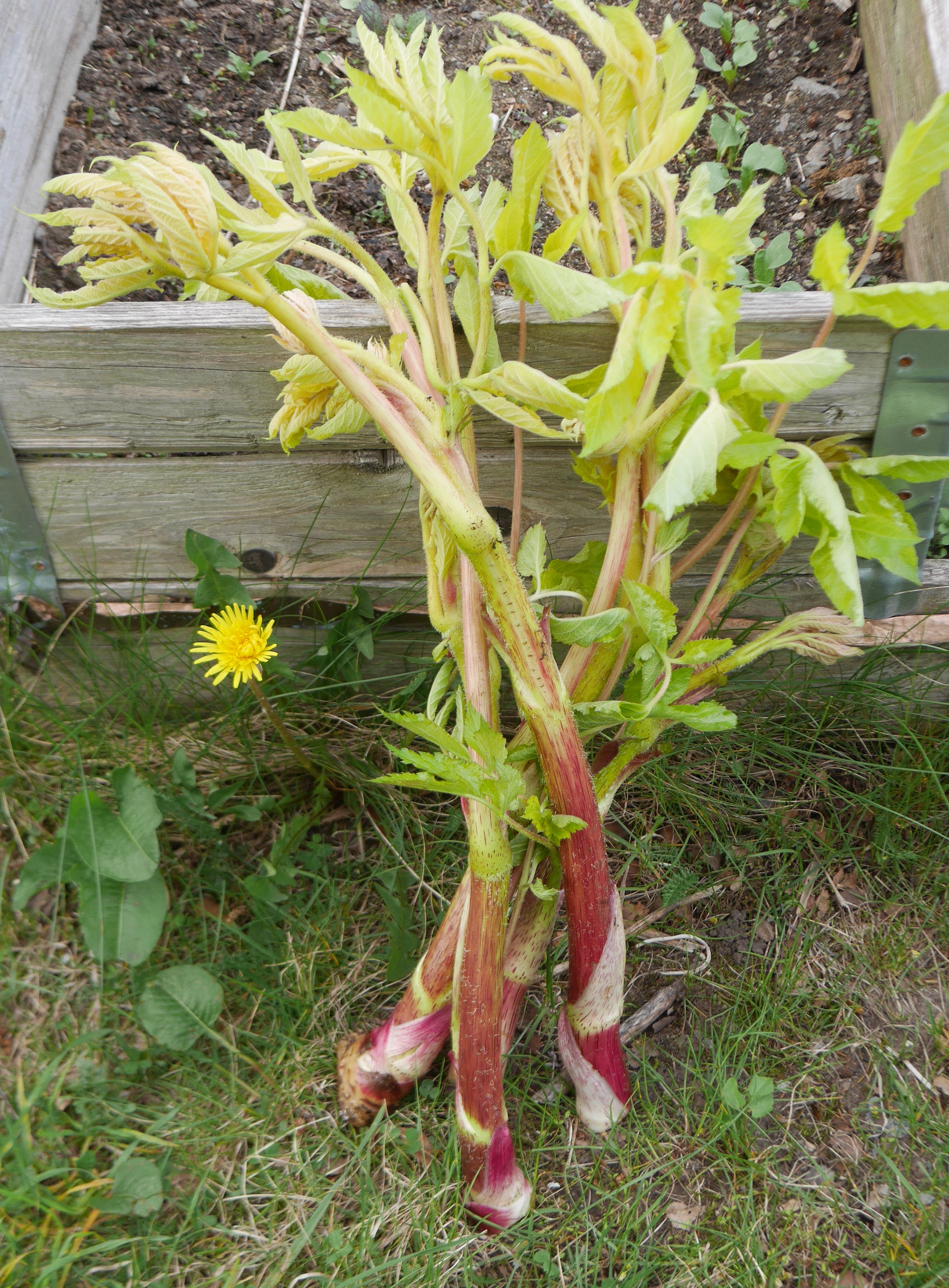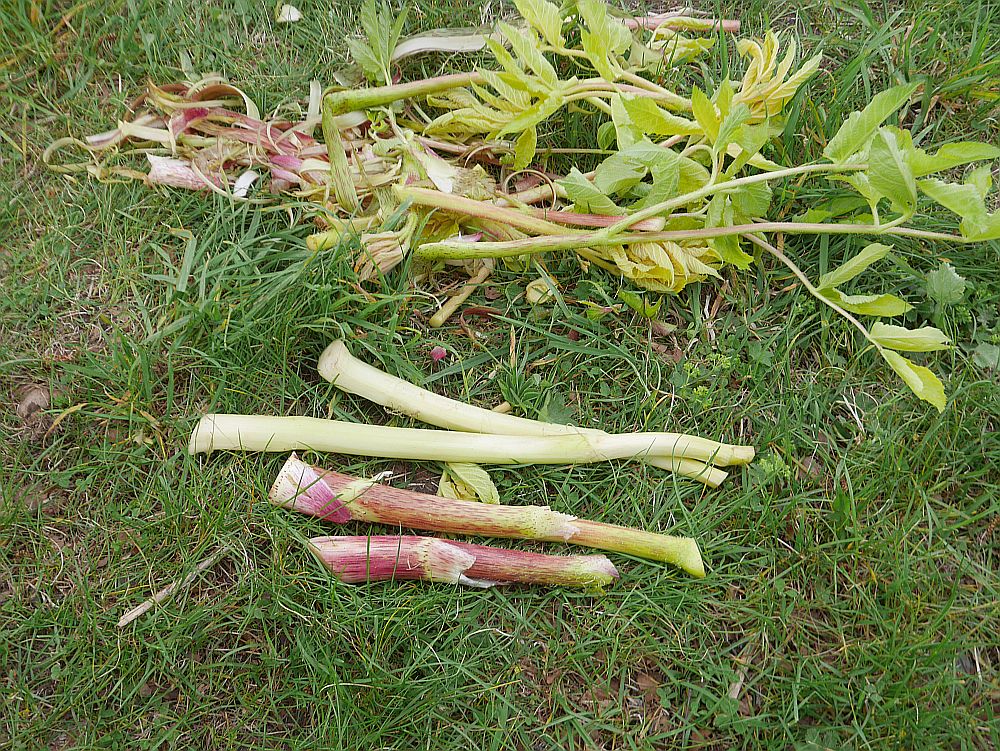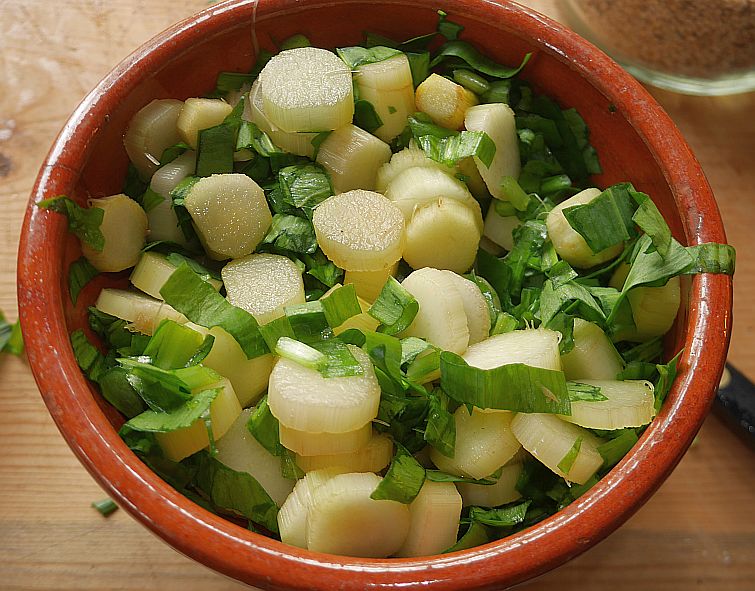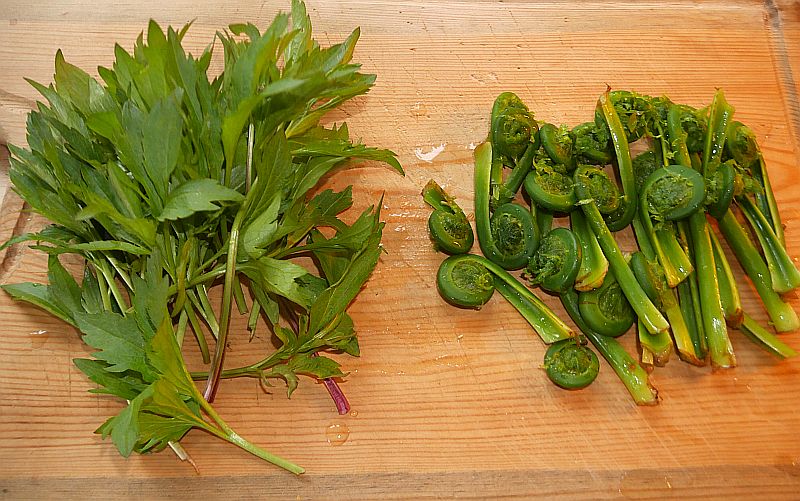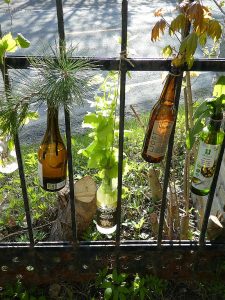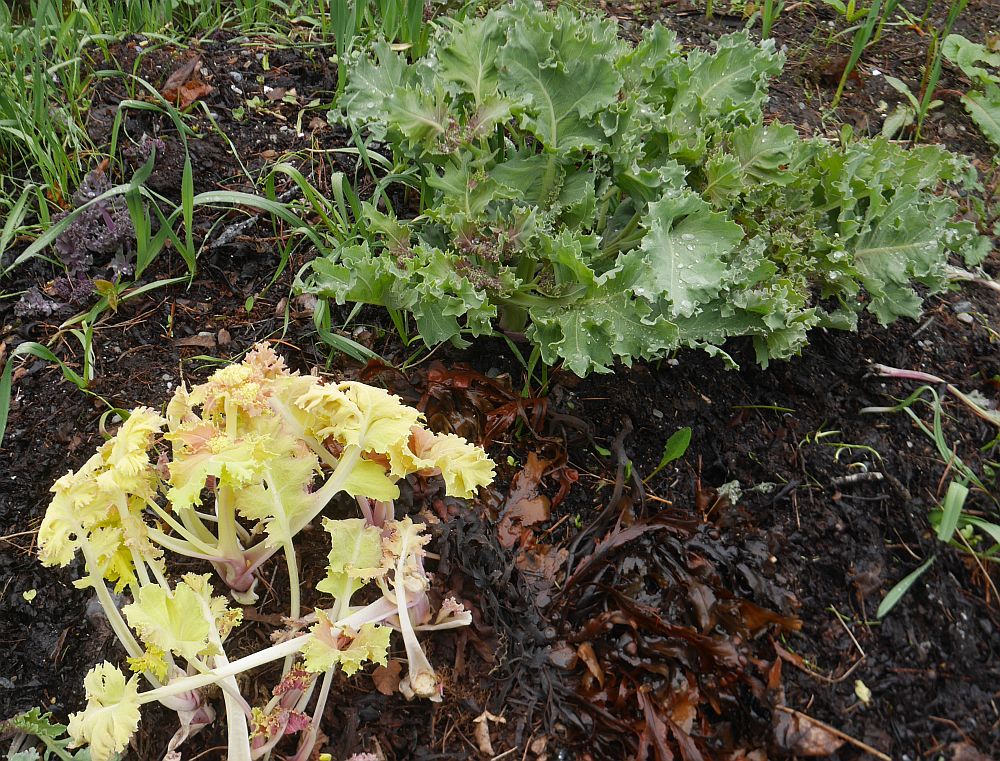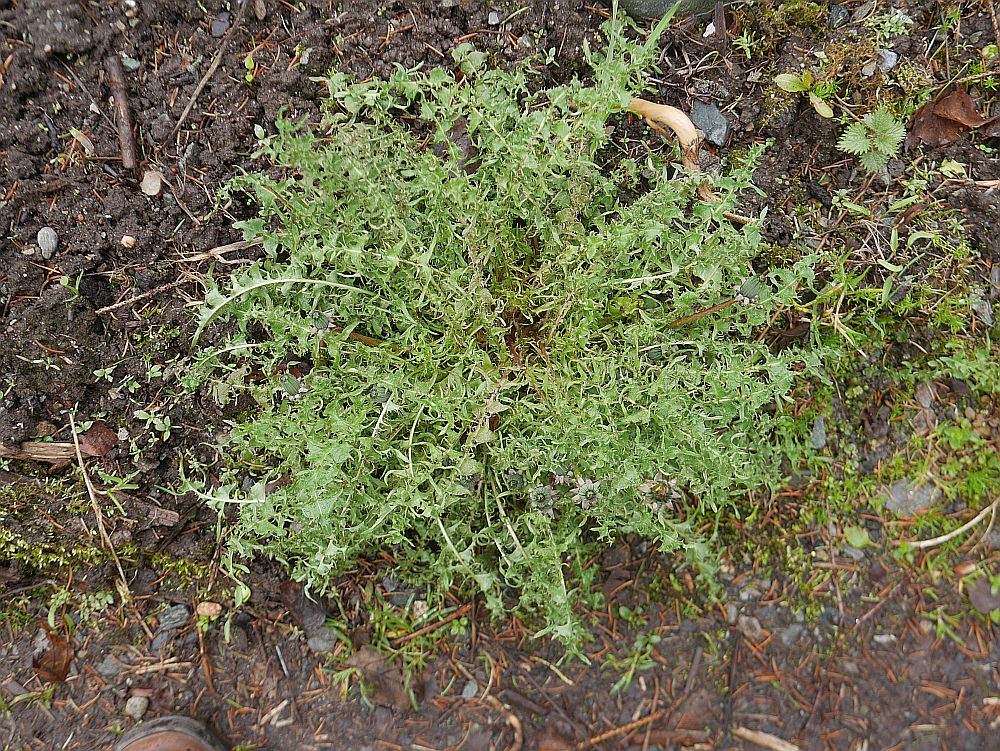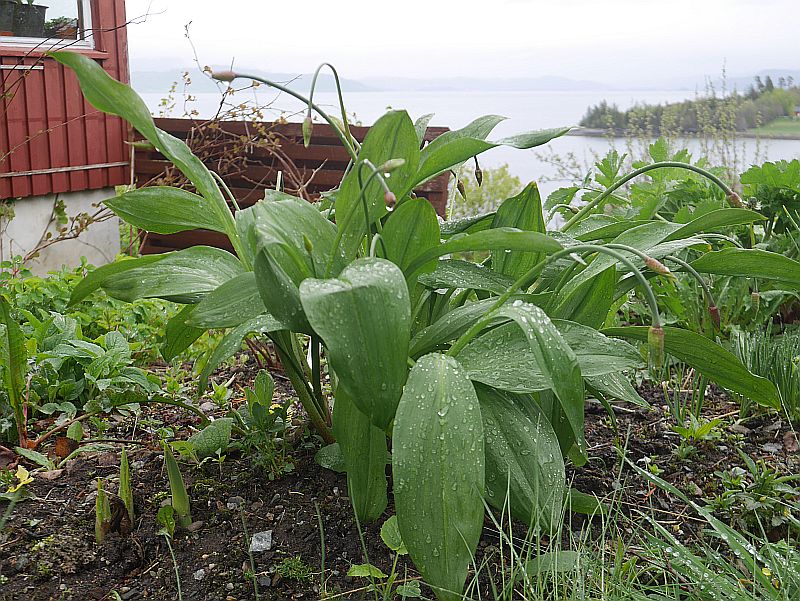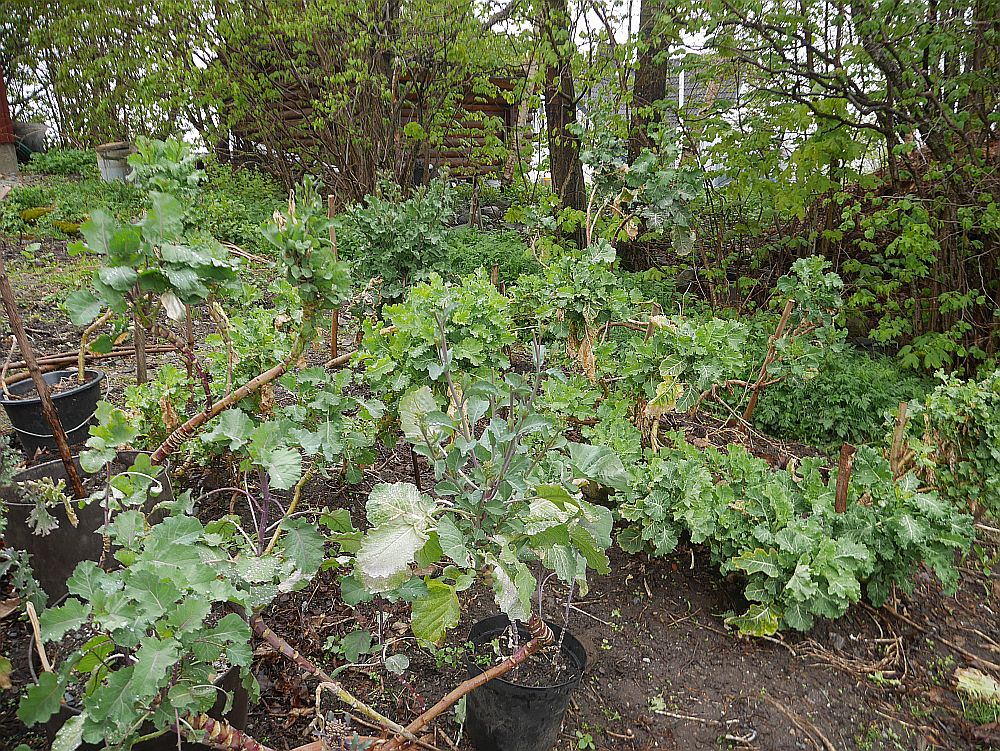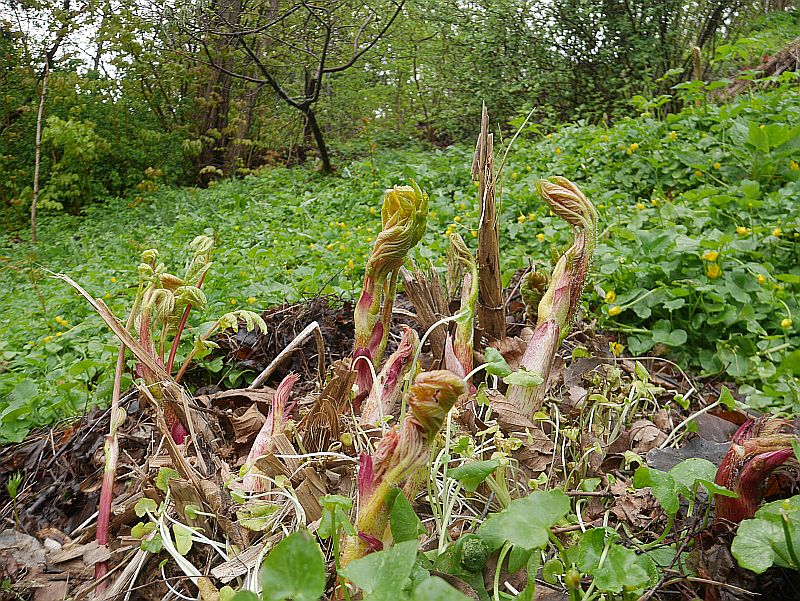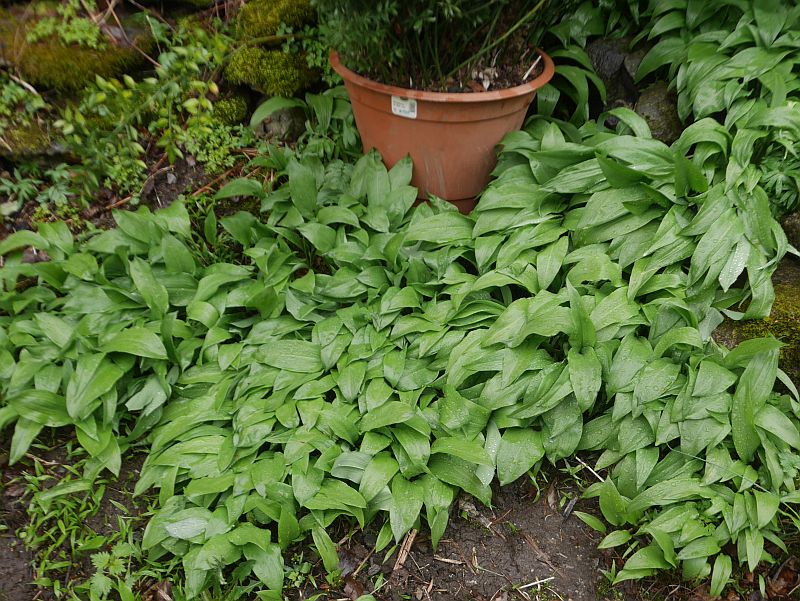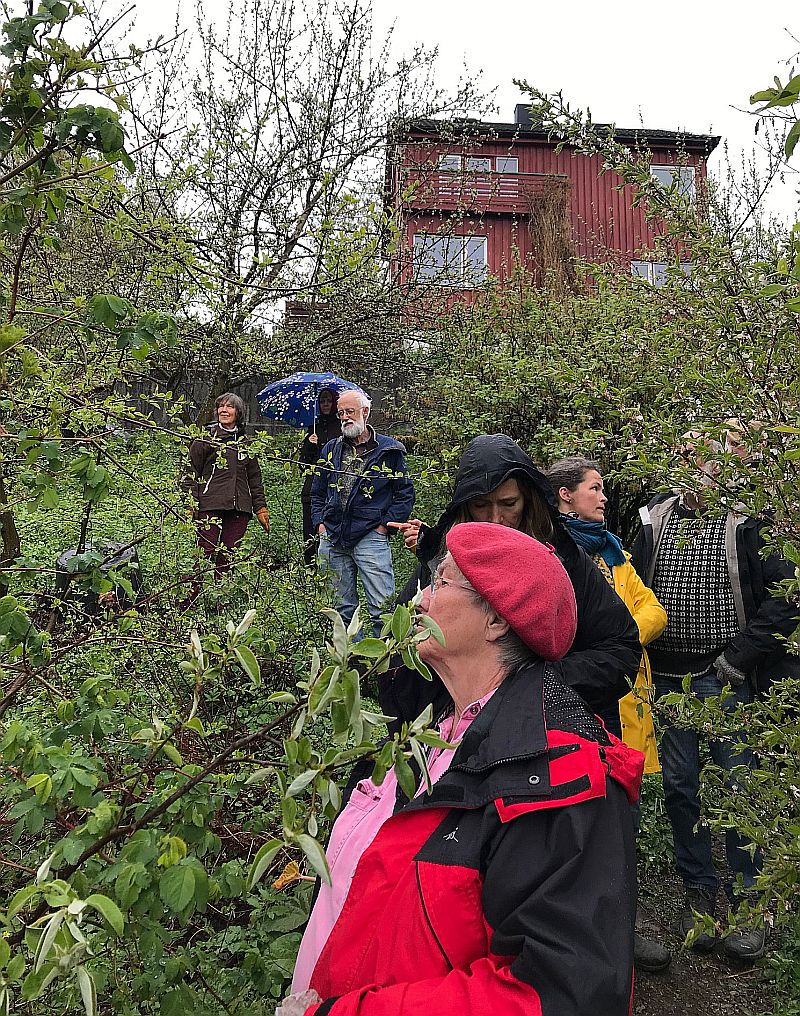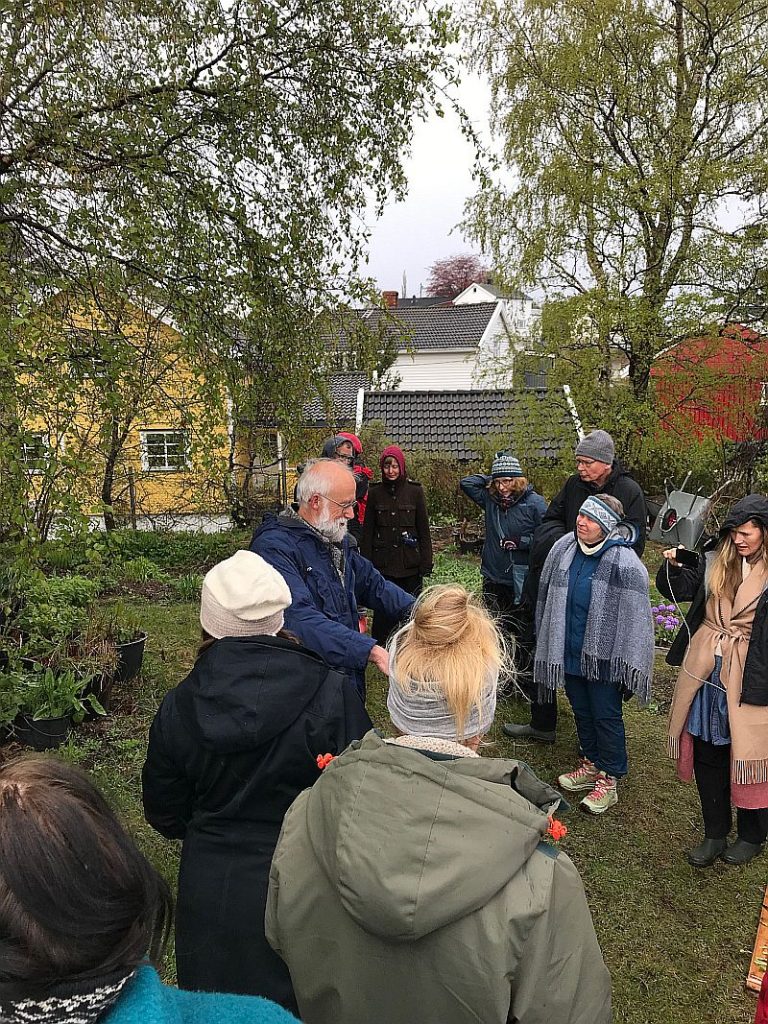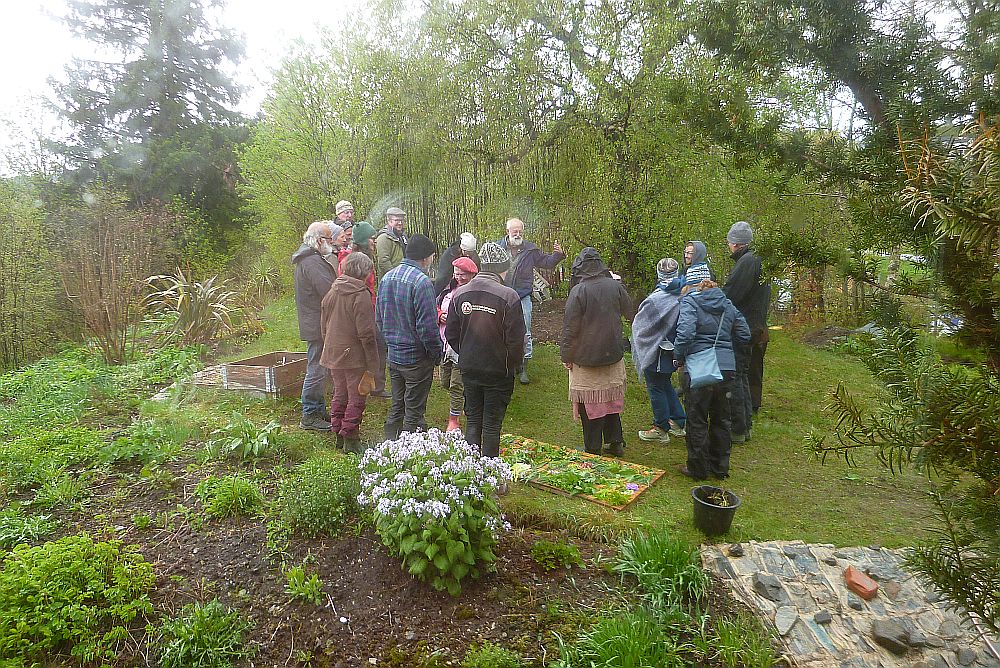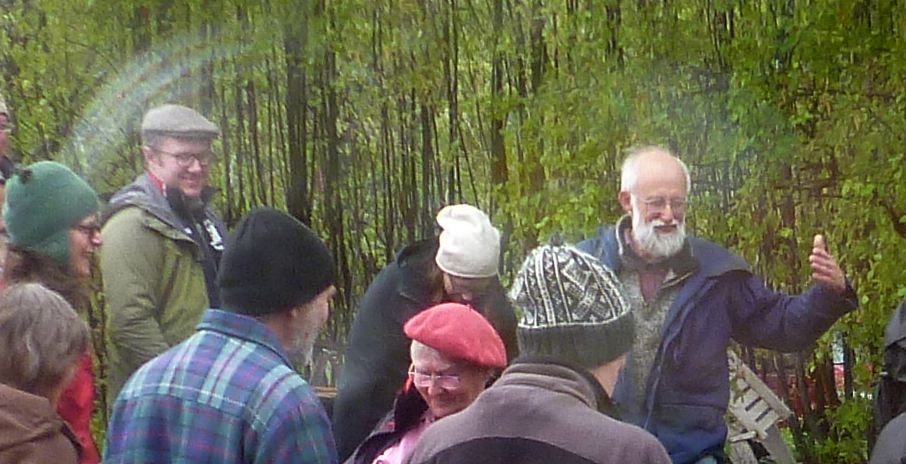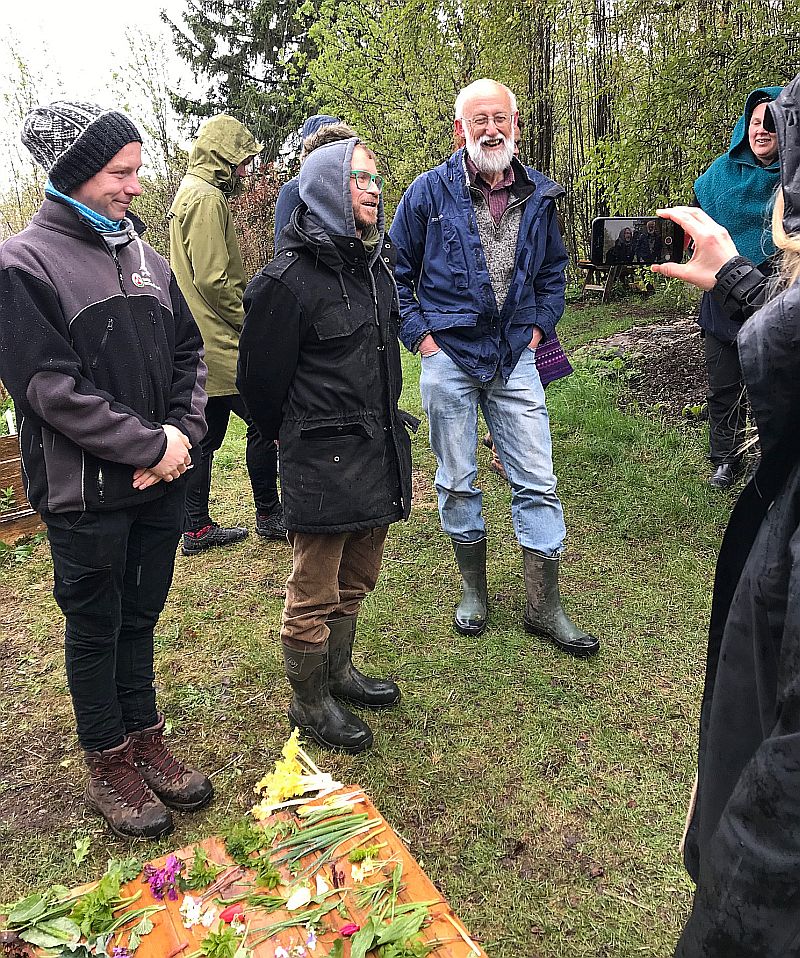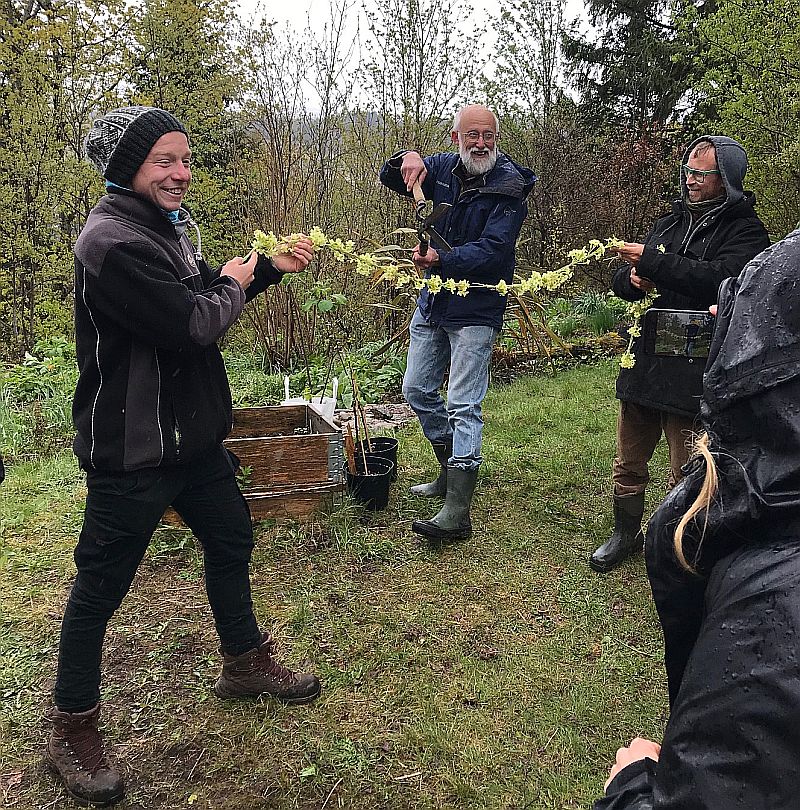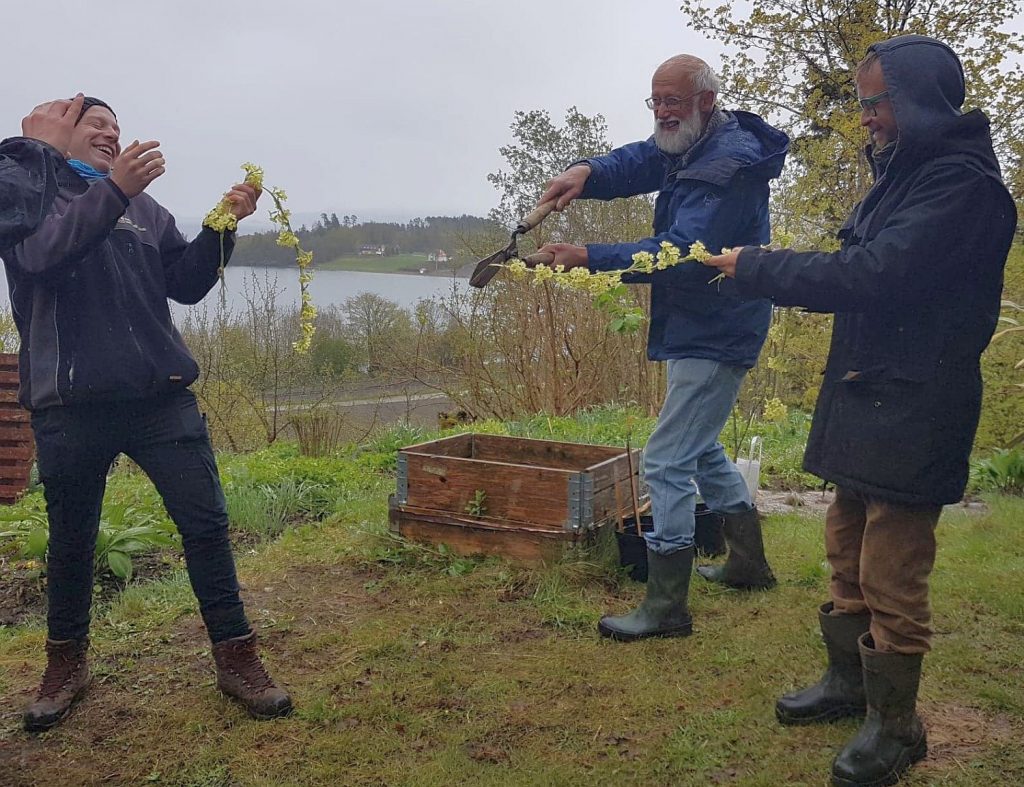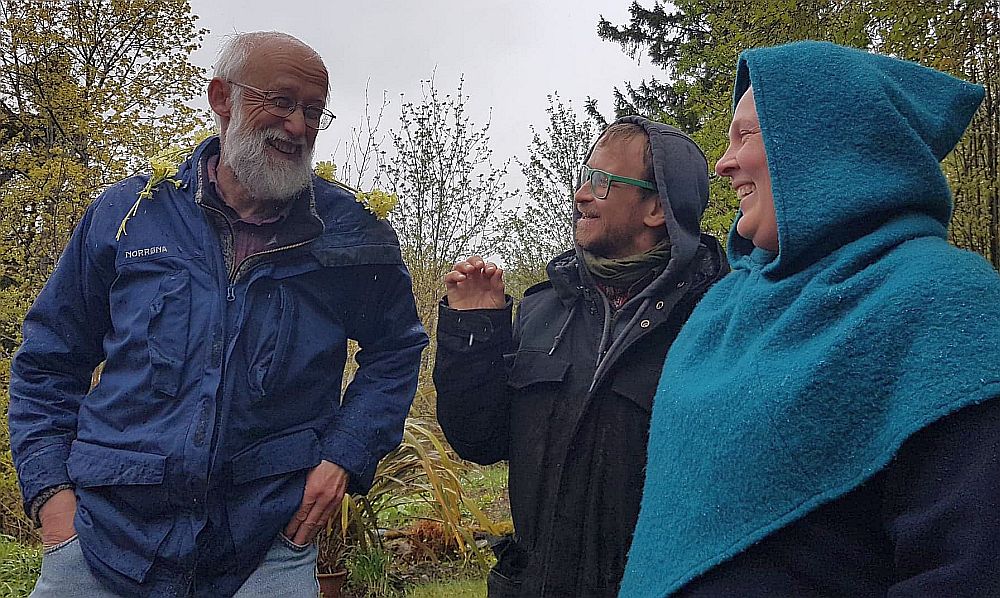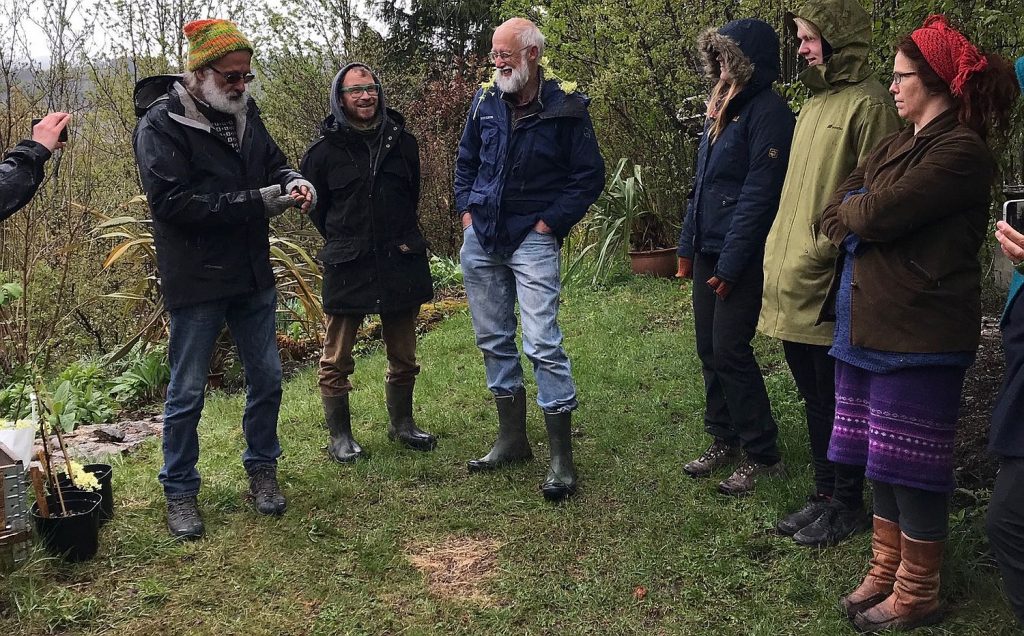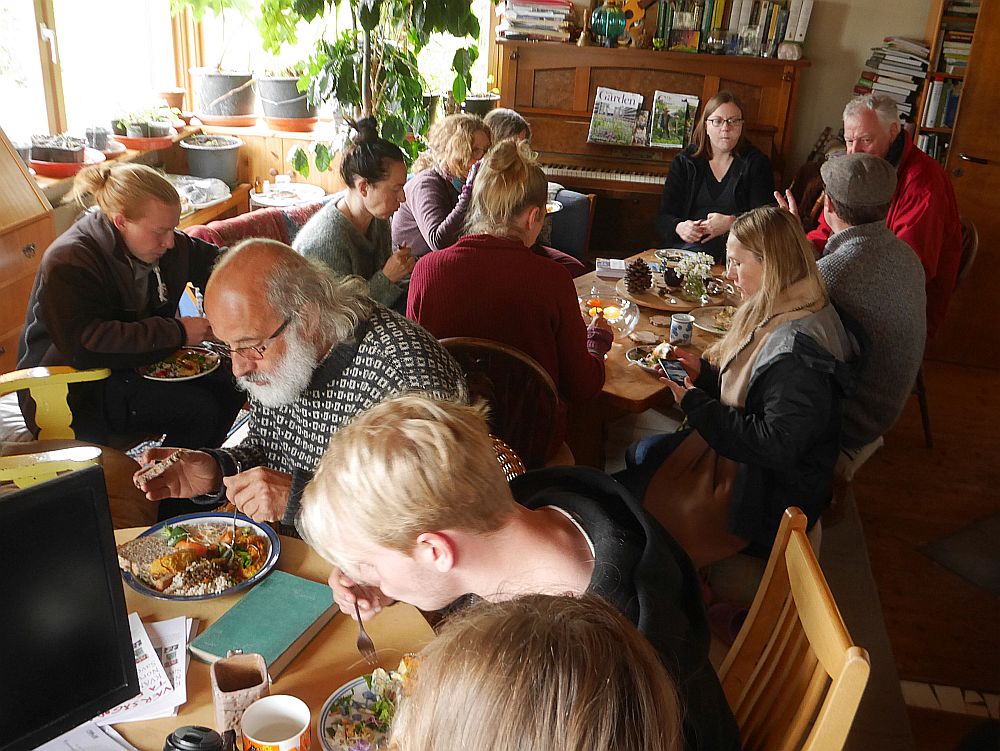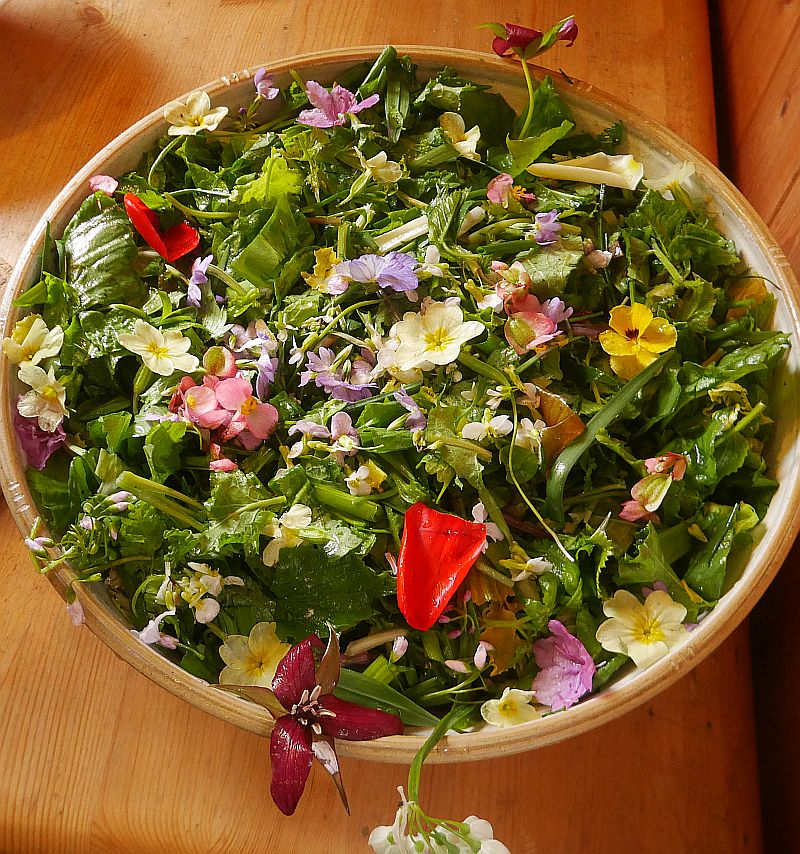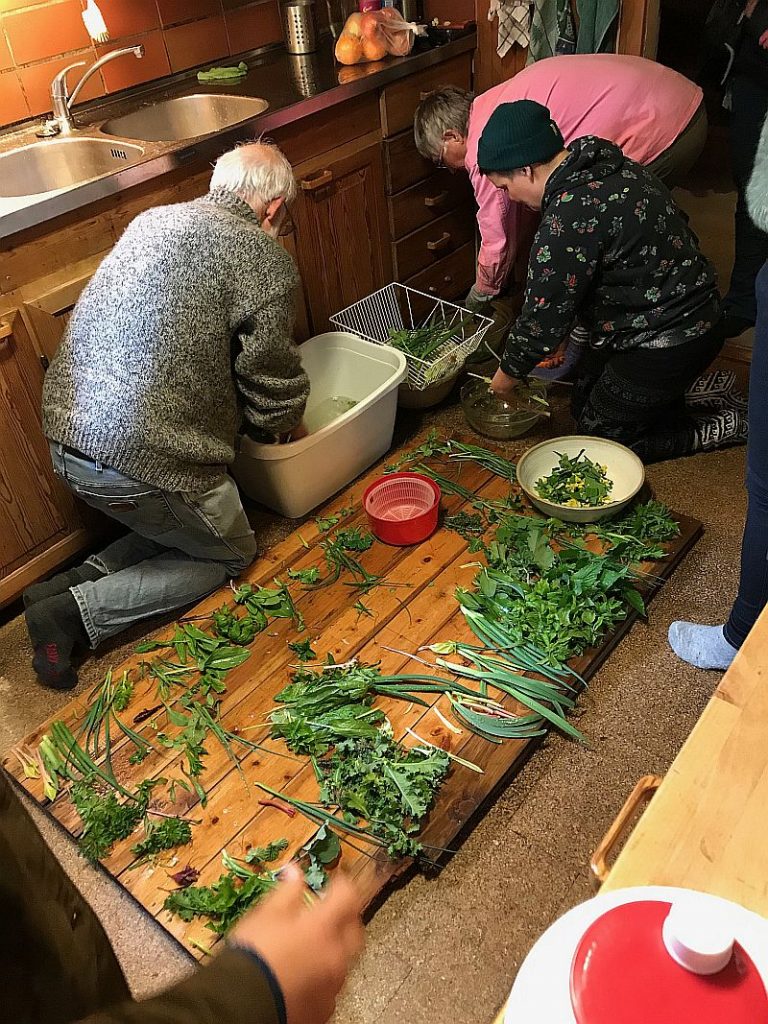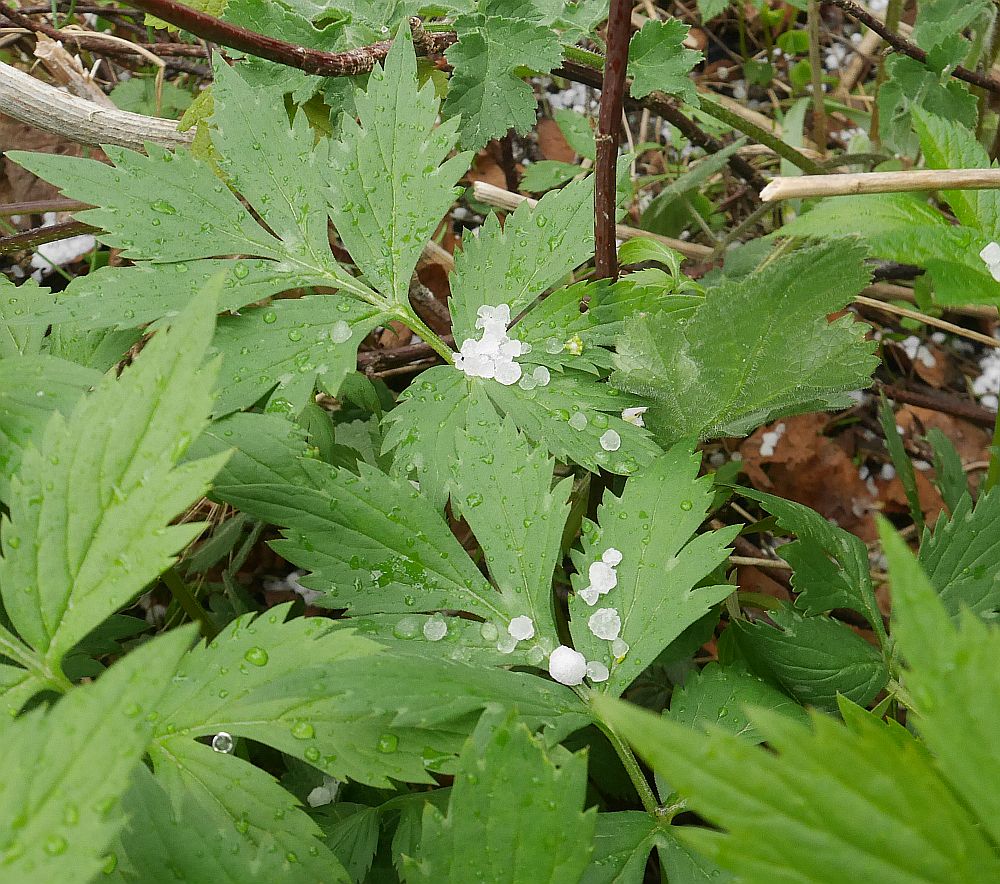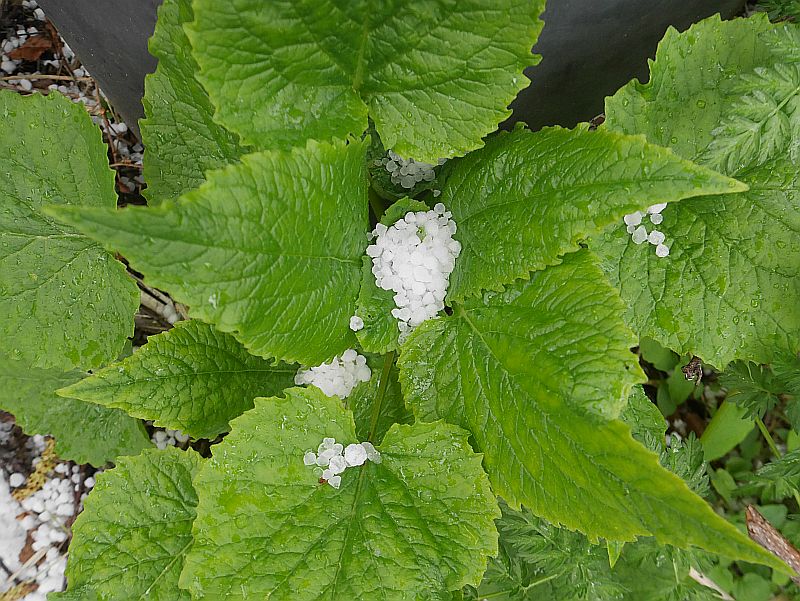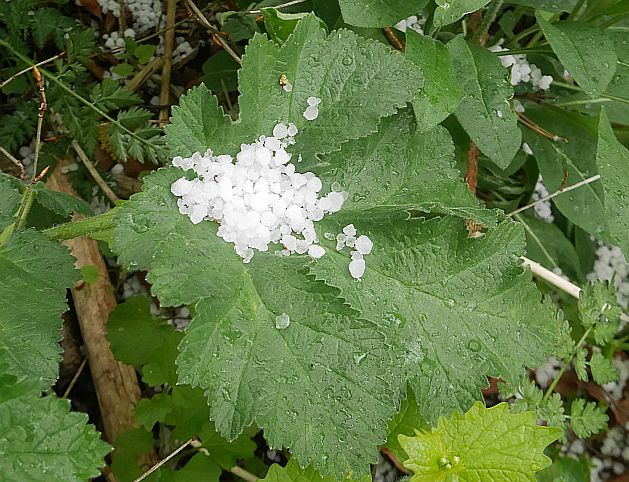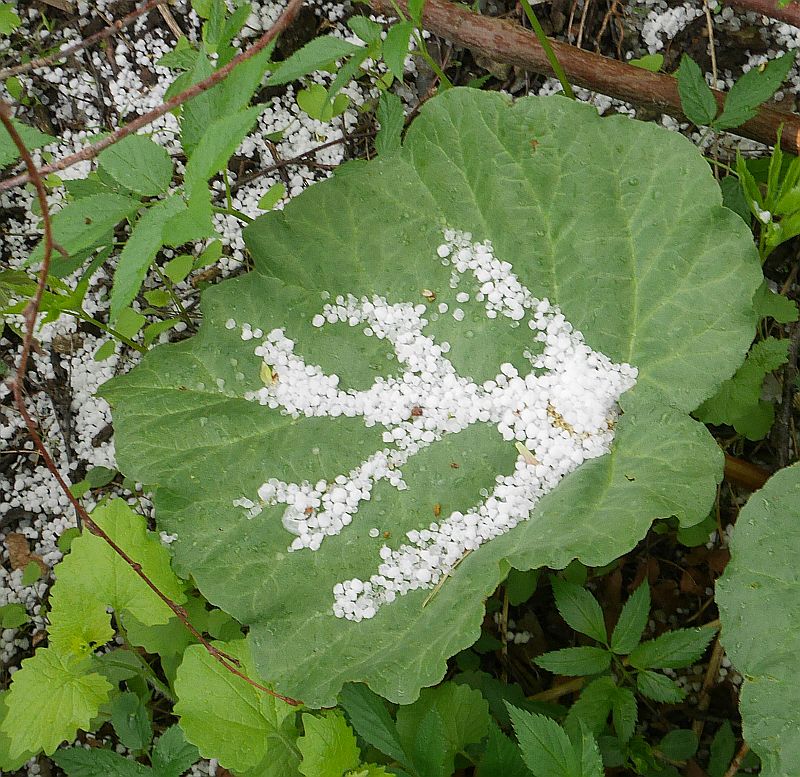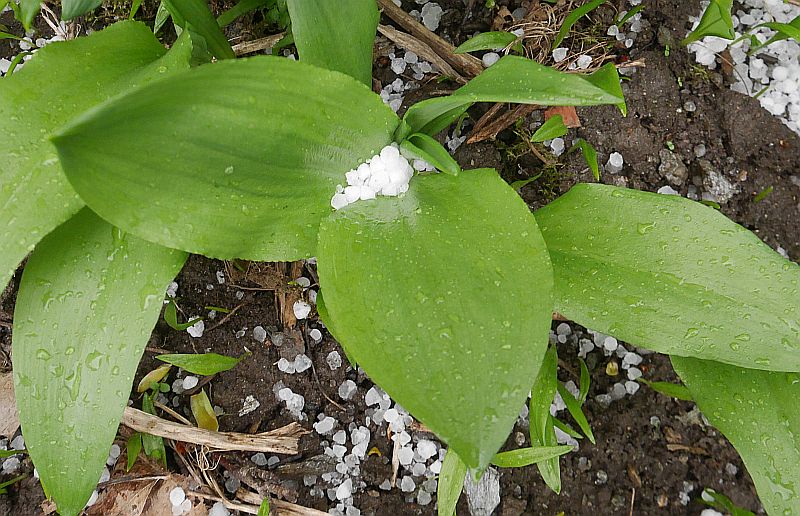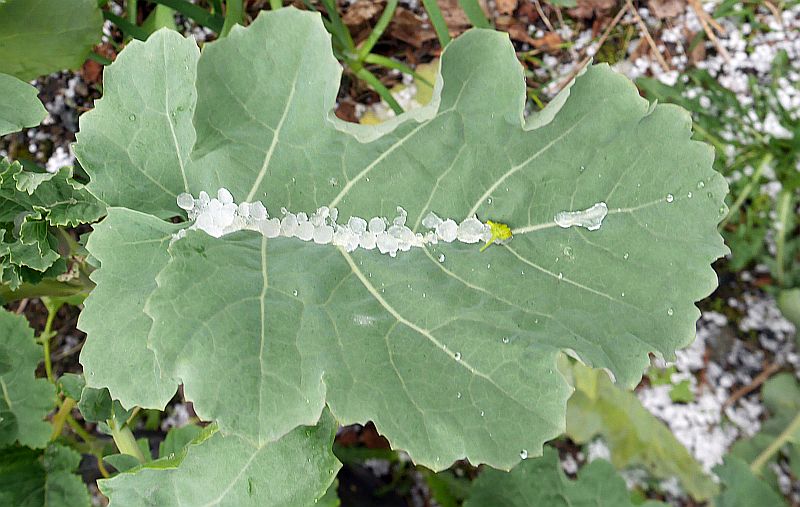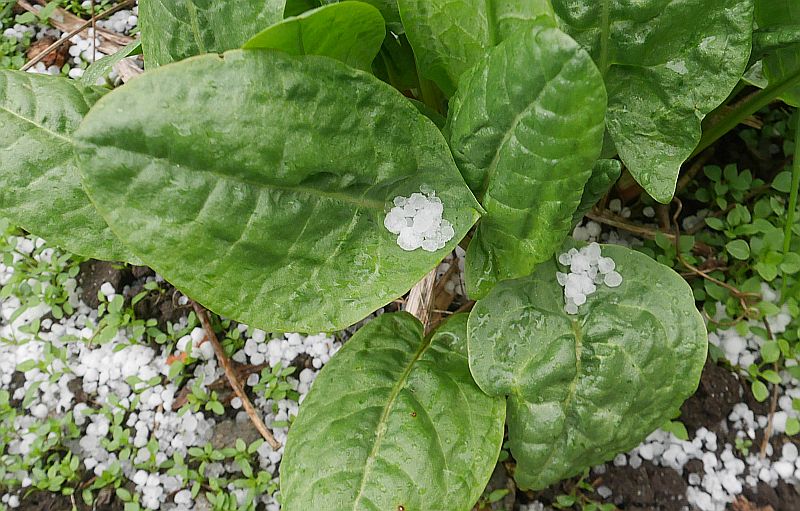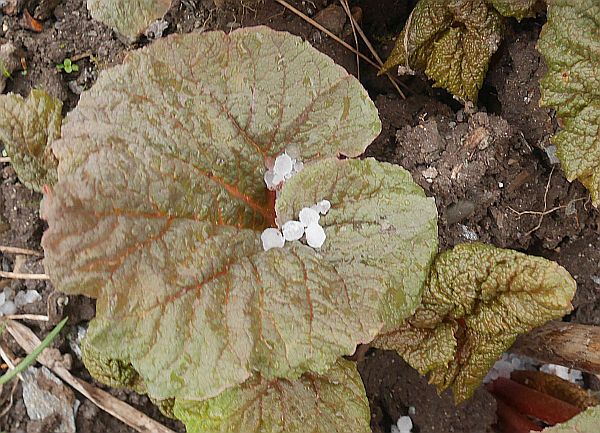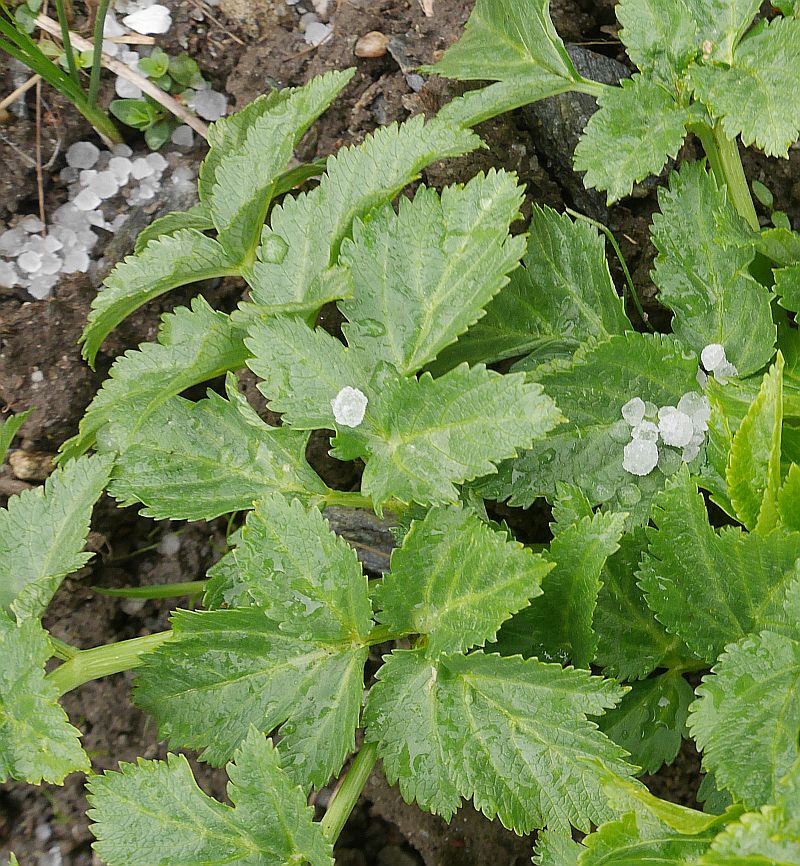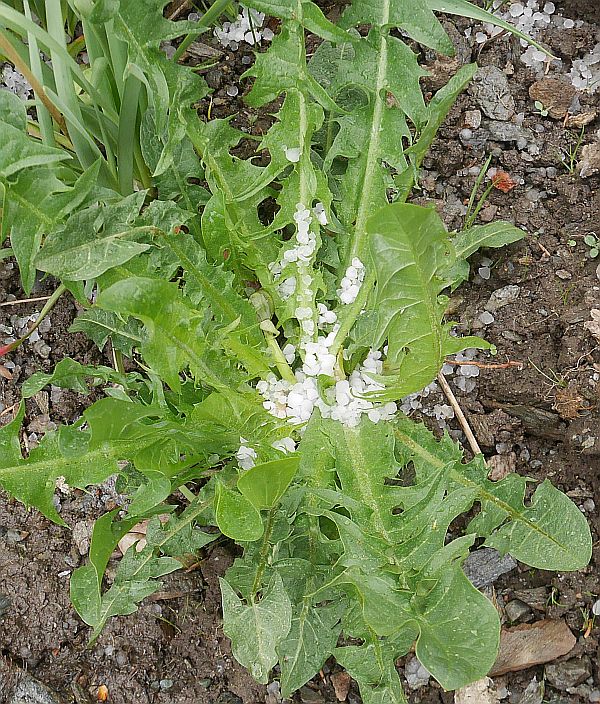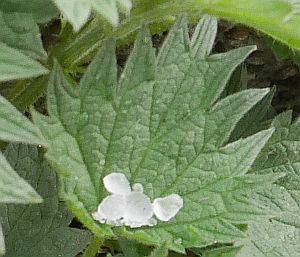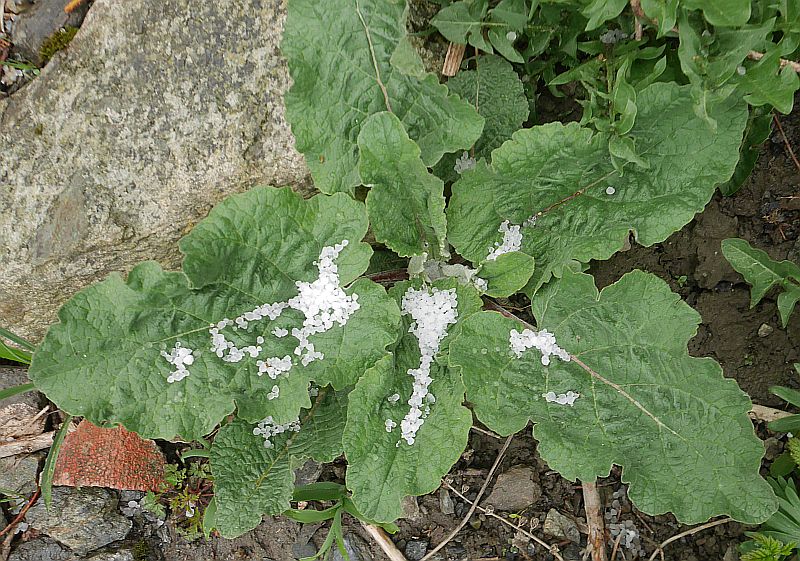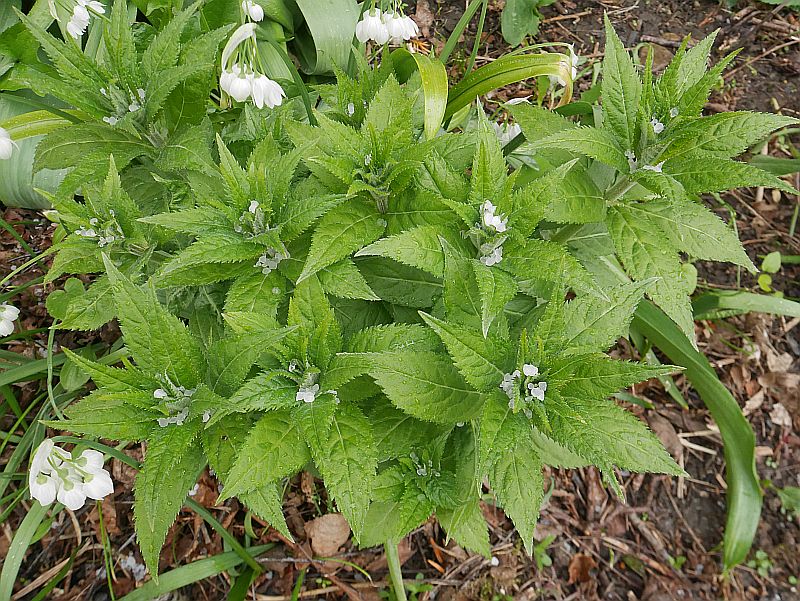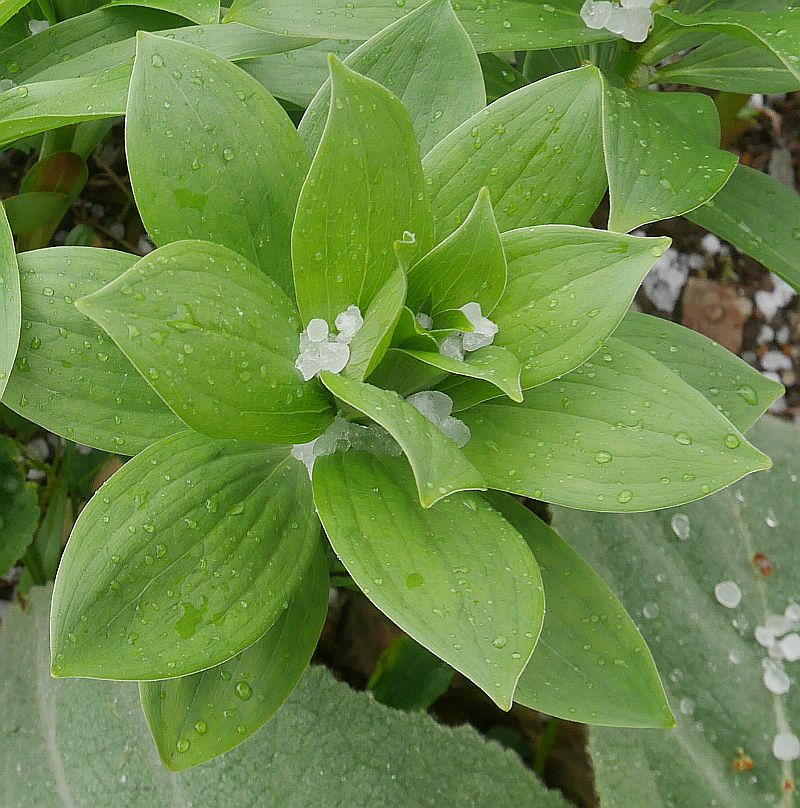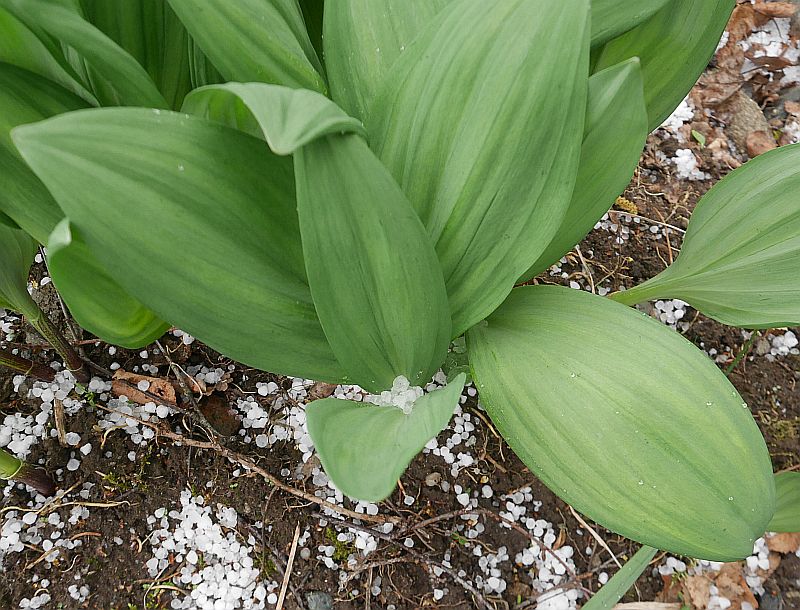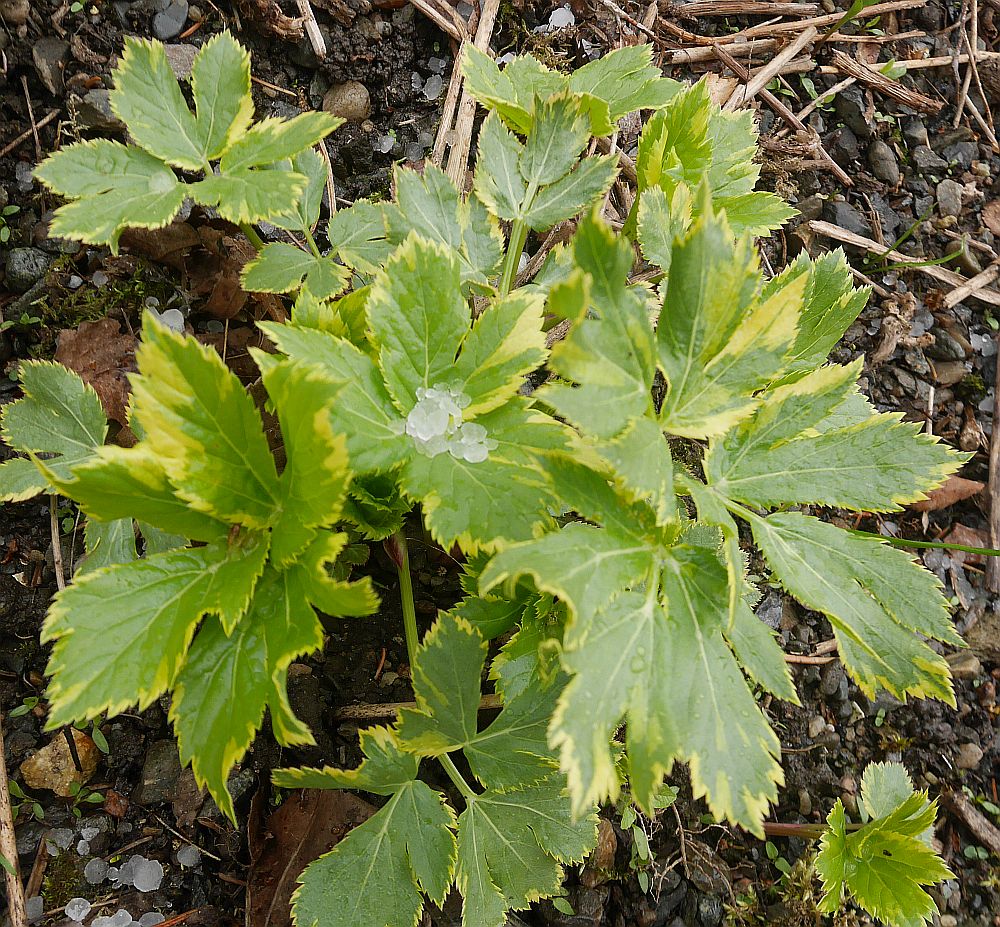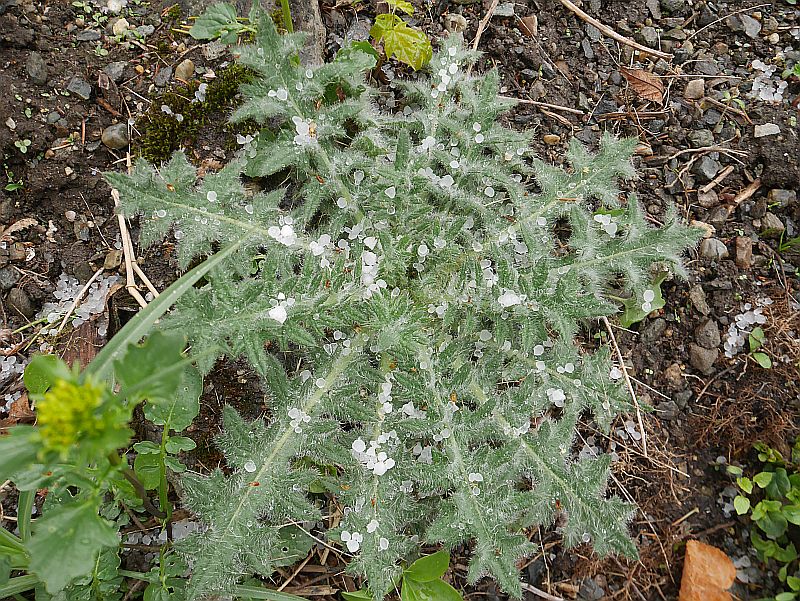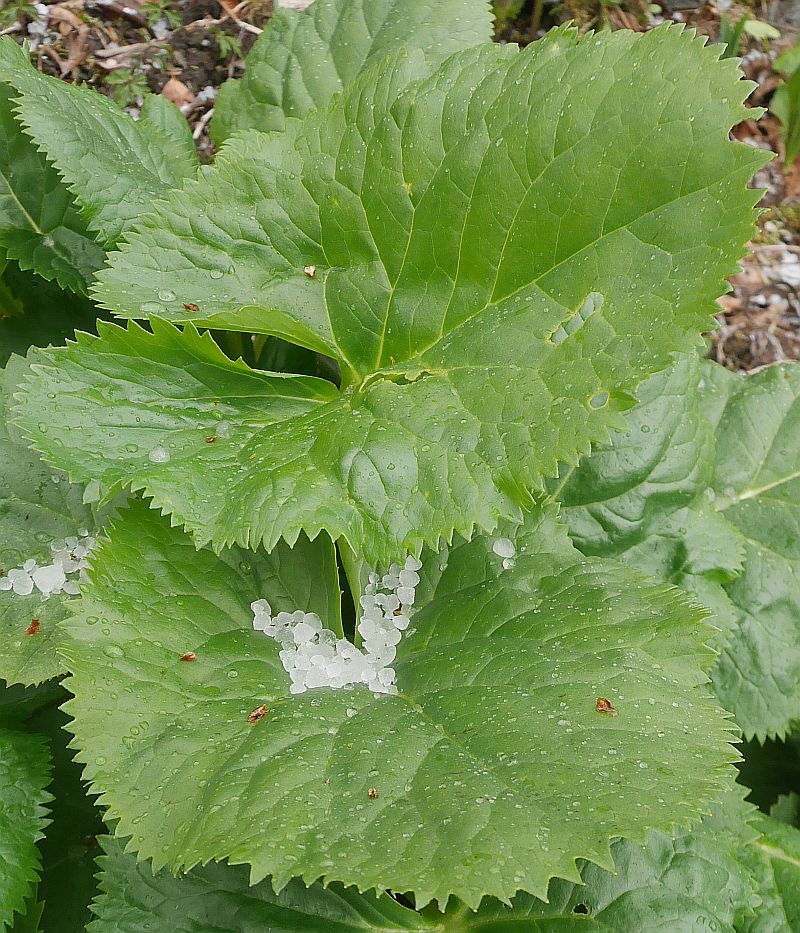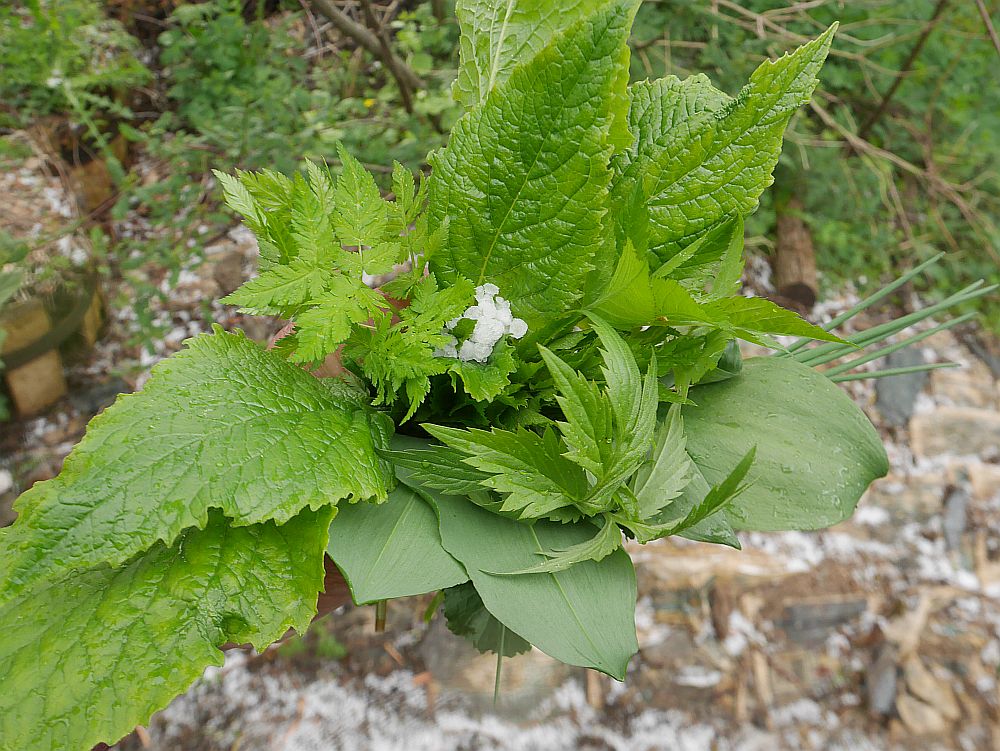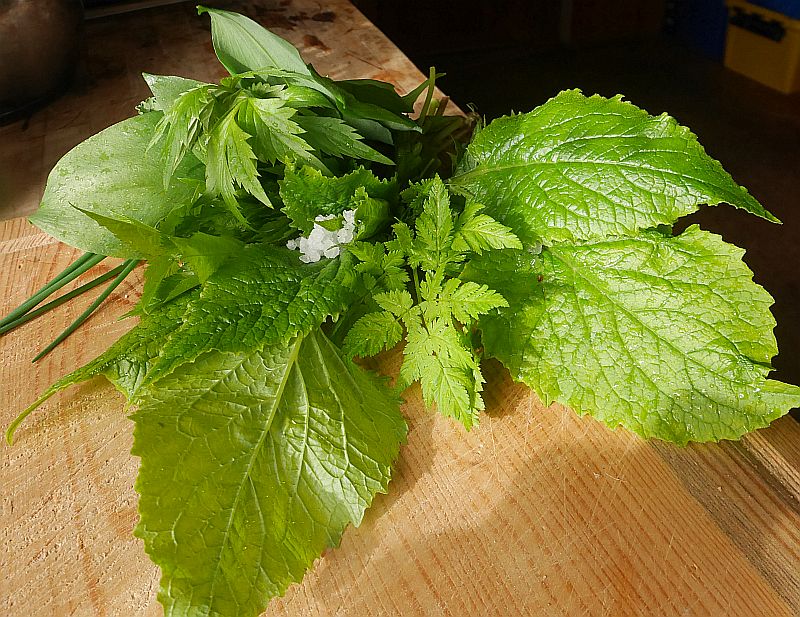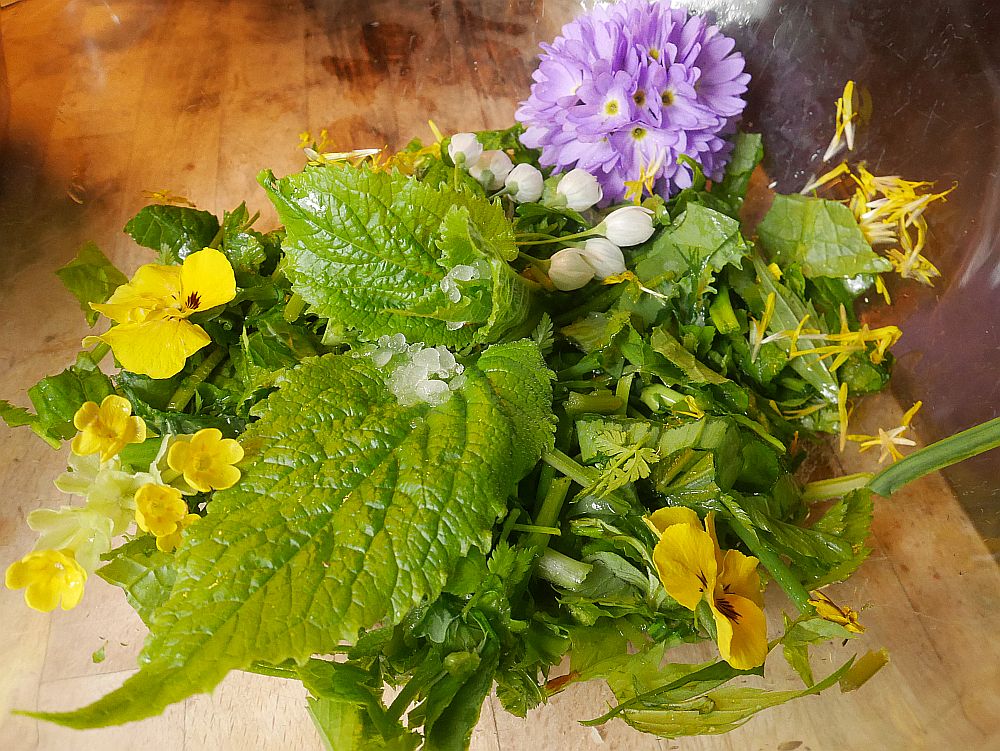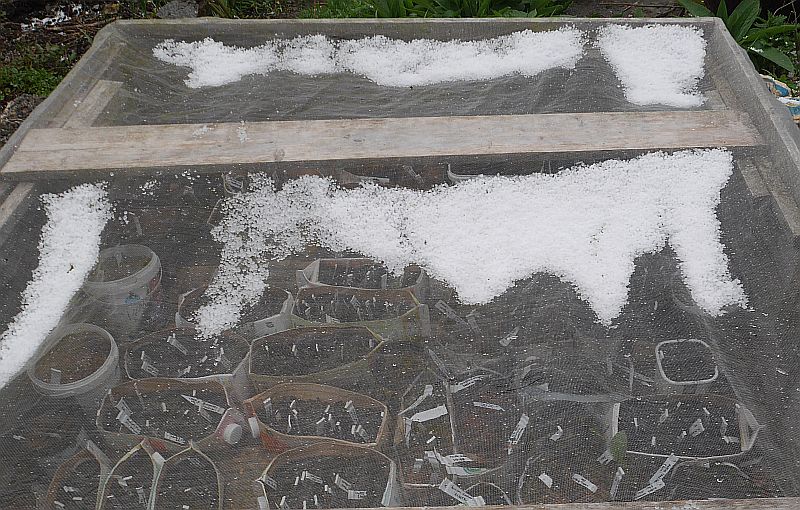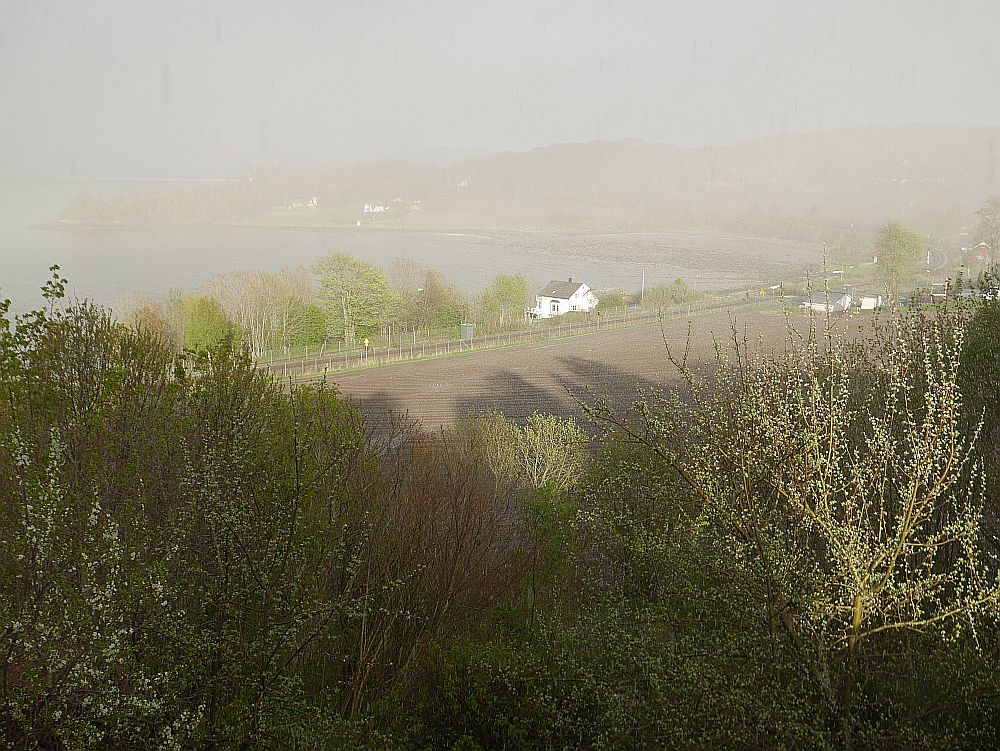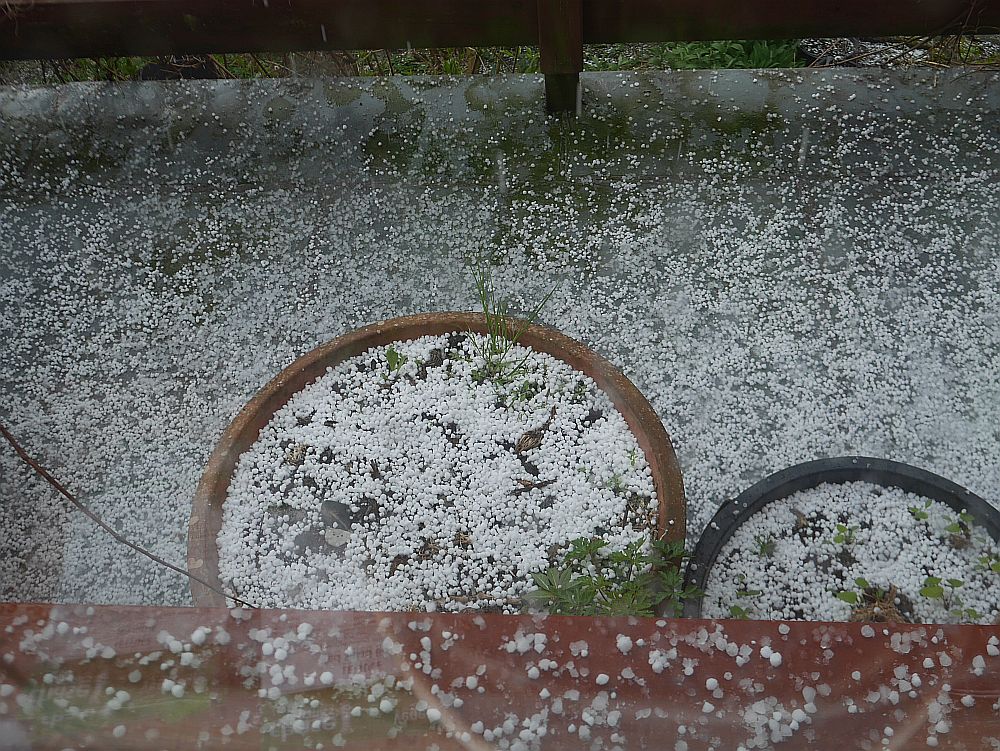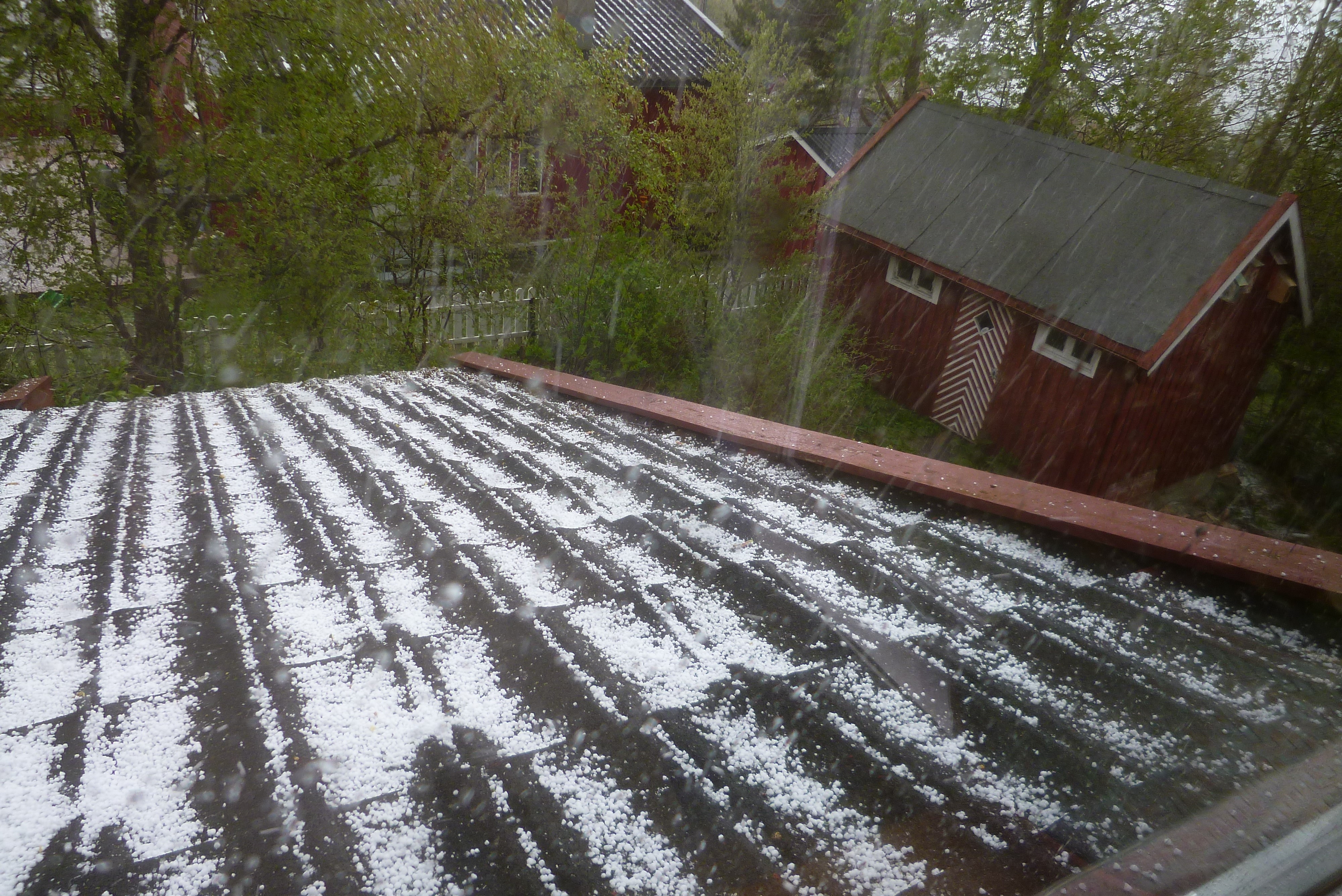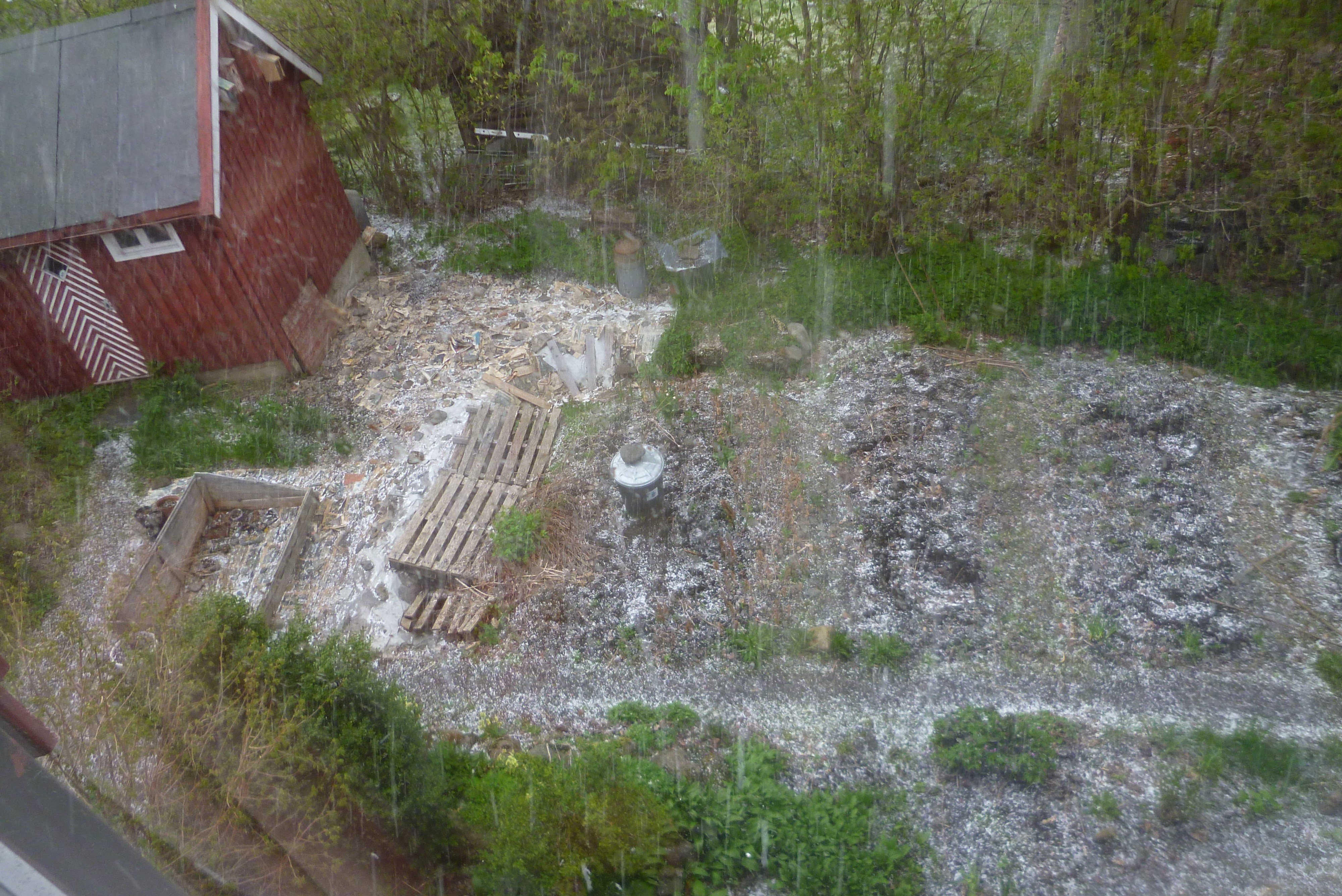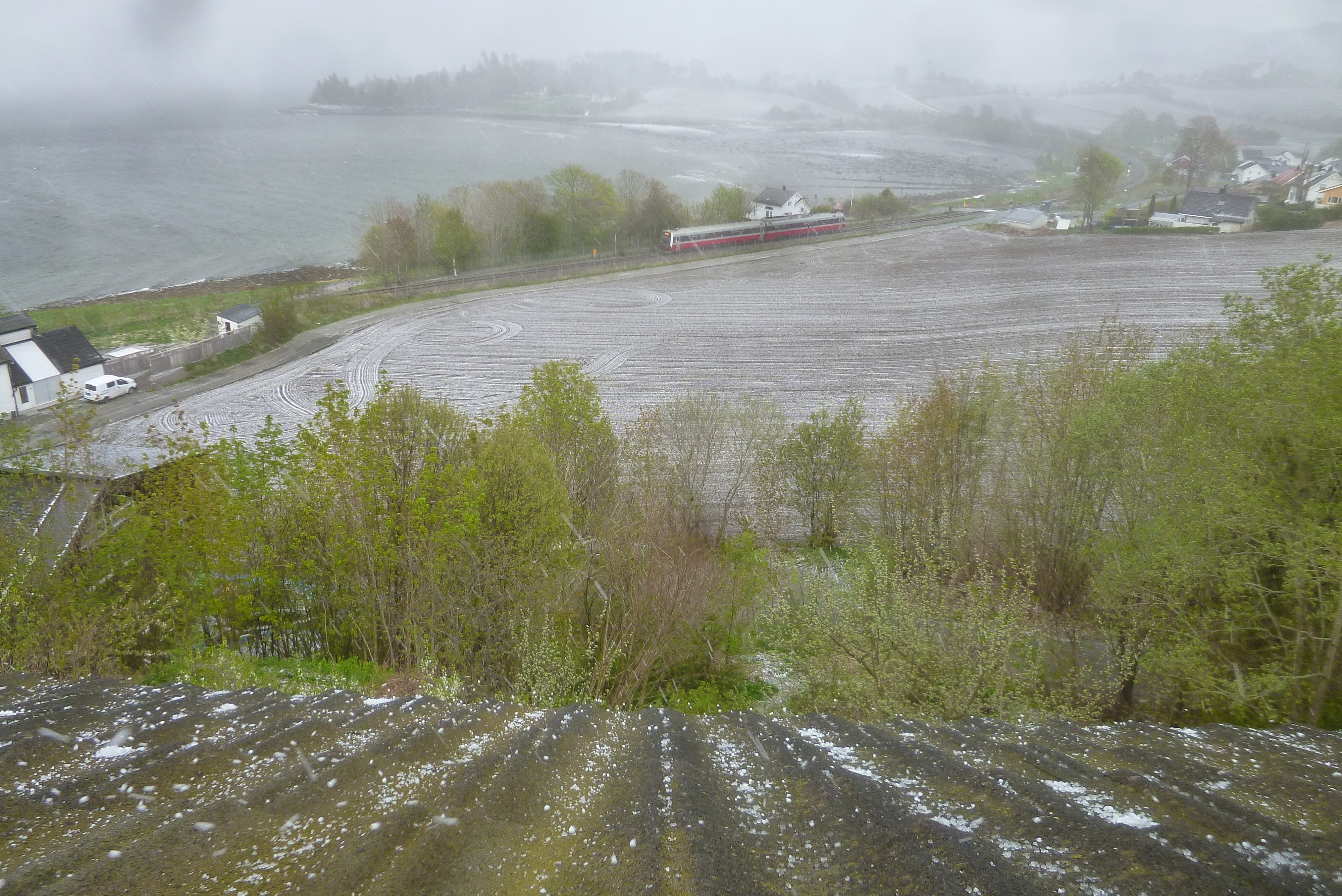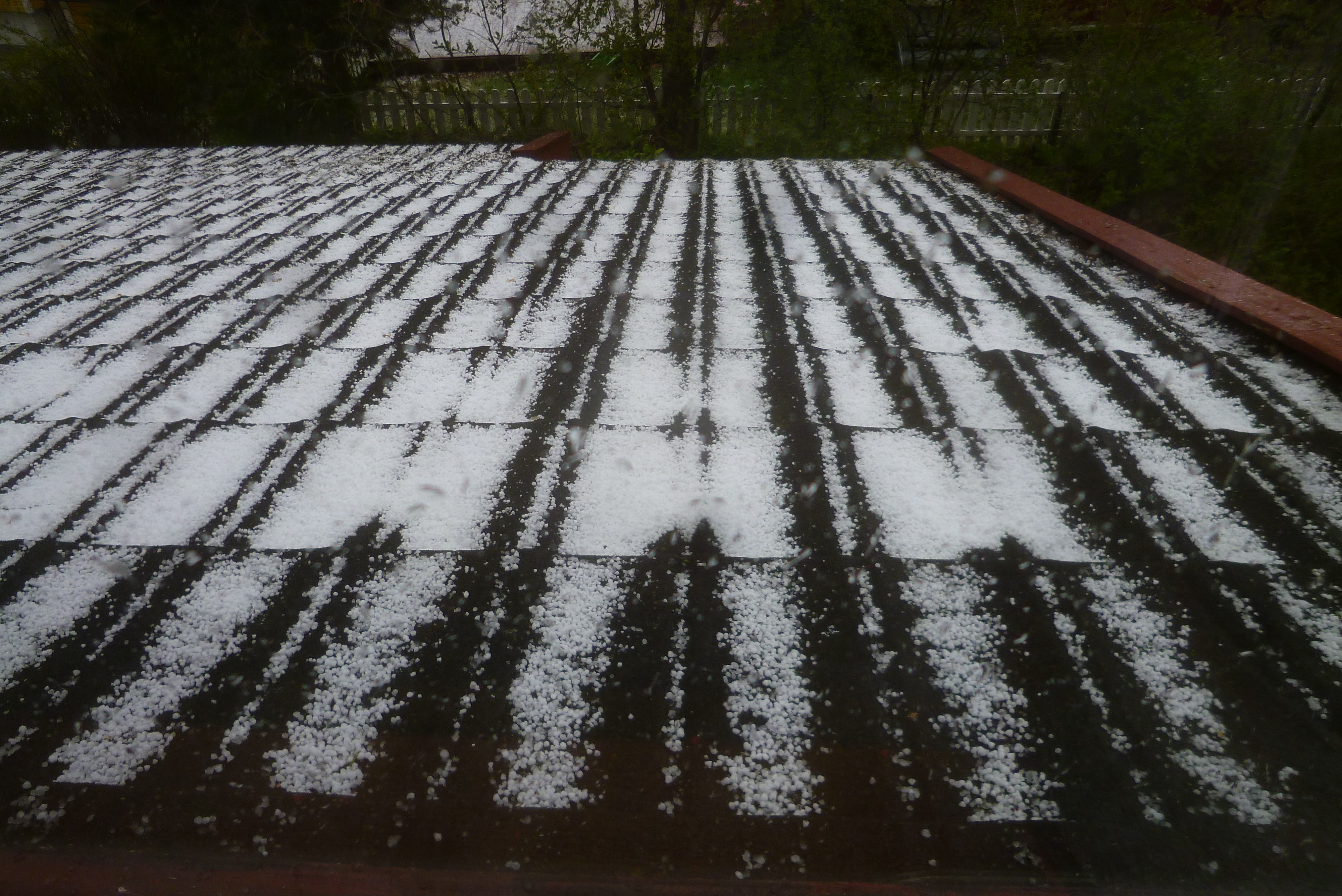The udo (Aralia cordata) shoots had begun to lift the forcing bucket, so time for the annual udo salad, a variant this year, East meets West salad…the udo paired with garden grown ramsons (ramsløk)! Delicious!
Category Archives: Perennial vegetables
Bellflower-chokes / Storklokkeskokker
I’ve previously introduced the gourmet part of the dandelion, the dandichoke! I write in my book:
My favourite foraging author “(Samuel Thayer’s) favourite dandelion vegetable is what he calls dandelion crowns, as named originally by Euell Gibbons (1961). I prefer to call them dandichokes, as both these and artichoke hearts are located below the flowers. In the early spring, the very young flowers appear at the surface. The dandichoke is just the self-blanched crown between the top of the root, which is a bit below the surface, and the developing flowers. Although small and difficult to clean, they are very tasty”. See the picture below!

The same applies to another of the 80 in my book, Giant Bellflower (storklokke) which also has a delicious (sweet tasting) self-blanched stem between the root and the surface….bellfower-chokes or, even better in Norwegian, storklokkeskokker! I discovered this accidentally last year! I had earlier noted in my book the sweeter tasting spring shoots after blanching (covering to excude light).

Appalachian Greens
I can go out into my garden and “forage” spring greens from anywhere in the temperate Northern Hemisphere! This week I foraged possibly the top two traditional spring greens of the Appalachian mountains, one of them, known as Sochan (so cha ni) by Native Americans, for the first time! Sochan has also now entered my all time top ten perennial vegetable list and would definitely have been in my book if I had discovered it before as it’s also a fantastic edimental! It is Rudbeckia laciniata, known as Cut-leaf (or Green-headed) coneflower or Golden Glow!
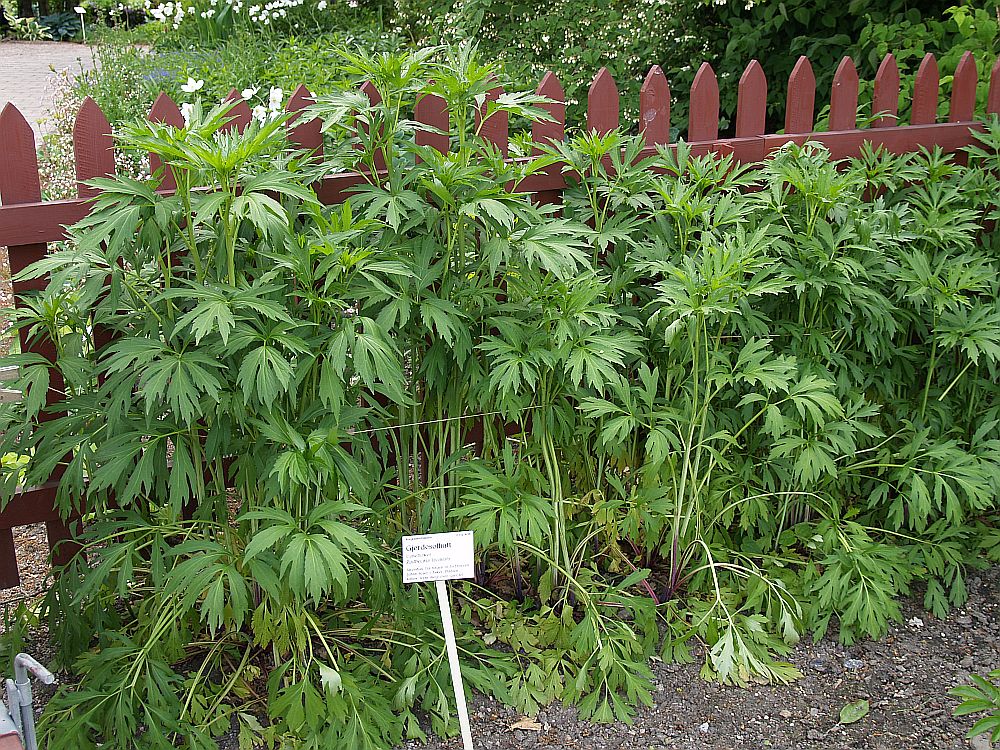
Here in Norway, the double-flowered cultivar “Hortensis” (also sold in the UK as “Golden Glow”) is a common ornamental known as “Gjerdesolhatt” or “Kyss meg over gjerdet” (Kiss me over the fence) reflecting on the fact that it’s often planted next to fences.
I’m not sure where I first heard of its edibility, but another Norwegian gardener sent me a plant 10 years ago and it’s since spread slowly where I placed it in a shady spot (sunny in spring before the leaves of an apple tree shade it out!):
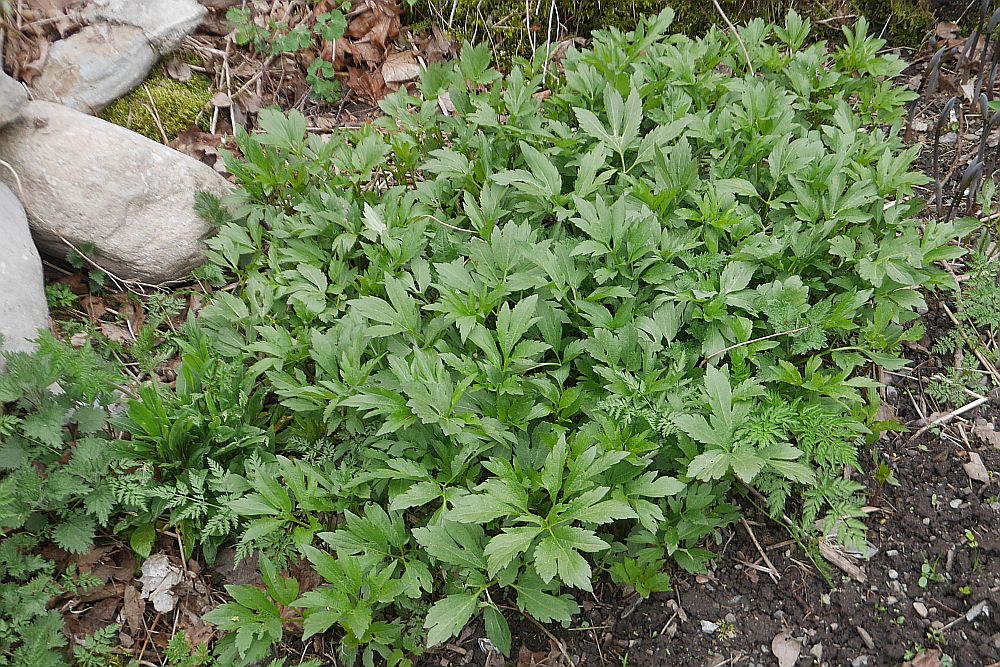
It is well documented as probably the most important spring vegetable of the Cherokee in the Southern Appalachians in Moerman’s Native American Ethnobotany, which is probably where I first noted its edibility. It’s missed in Cornucopia II. The Cherokee ate the tender young leaves and stems cooked alone or with other greens such as poke (Phytolacca americana), Ramps (Allium tricoccum), Rumex spp. (docks) and eggs. They were also fried with fat and were also dried for later use and also eaten as a cooked spring salad or as celery (presumably raw). Unlike some other Native American veggies, this one doesn’t seem to have been adopted by the Europeans and remained a closely kept Cherokee secret!
I didn’t know of others who had eaten this plant and it wasn’t until I read Samuel Thayer’s glowing account of this plant (11 pages) in his gem of a book “Incredible Wild Edibles” (2017) that I was encouraged to give it a go! I also missed Mountain Gardener Joe Hollis’ video on this plant (https://www.youtube.com/watch?v=aBJncaj1ZPM; also from 2017).
It is believed to have similar medicinal properties to closely related Echinacea (also known as coneflower).
I finally got round to trying it for the first time last week and, wow, I hadn’t expected it to taste that good, slightly sweet and aromatic similar to other Asteraceae like Korean Aster scaber. We served it with probably the No. 1 North Appalachian spring edible, Ostrich Fern (Matteuccia struthiopteris).
The RHS Plant Finder in the UK lists 12 different ornamental cultivars available from UK nurseries!
In Norway, this species has escaped from gardens and is established in some places, but is not considered to have an ecological risk (low risk on the national invasives list). It is very hardy. My double-flowered clone doesn’t seem to produce seed.
ENJOY!
Forsøk med flerårige grønnsaker i fjellet
Sansai-lauget i KVANN er igang med å teste flerårige grønnsaker i fjellene. Dette er den første forsendelsen som Anders Nordrum skal teste i over 900m på stølan hans i Valdres hvor han allerede dyrker hvitløk med hell!
Grand Opening of The Edible Garden Permaculture LAND Centre
Grand Opening of The Edible Garden Permaculture LAND Centre
(Thanks to Berit Børte, Kjell Hødnebø, Lone Dybdal, Elin Mar, Bell Batta Torheim, Inger Line Skurdal Ødegård and Margaret M. Anderson for the pictures )
Sunday 5th May was a cold showery day here in Malvik and the 3rd day of KVANN’s (Norwegian Seed Savers) annual meeting weekend in Trondheim and Malvik. This was also the day of the official opening of my garden as a Permaculture LAND centre, which was celebrated by a primula ribbon cutting ceremony and the LAND multi-species salad (how many ingredients? See below!). Meg had decorated the gate for the occasion, now a permanent feature:
25 participants from all over Norway met in the garden at 10:30. Due to the weather, we moved inside  where I gave an introduction to how the garden had developed into a permaculture Forest Garden despite the fact that I knew nothing of permaculture principles! The rain eased off, so we moved outside for a walk and talk around the garden with focus on the plants. The album below shows some of the plants we talked about:
where I gave an introduction to how the garden had developed into a permaculture Forest Garden despite the fact that I knew nothing of permaculture principles! The rain eased off, so we moved outside for a walk and talk around the garden with focus on the plants. The album below shows some of the plants we talked about:
I had got up at 6 am to pick the ingredients for the multi-species salad we made for lunch (all 146 ingredients) to celebrate the garden’s LAND status!
salad we made for lunch (all 146 ingredients) to celebrate the garden’s LAND status!
LAND: Learning And Network Demonstration network – a network of permaculture sites. Sites are set up to show permaculture in practice to visitors and volunteers in a safe, accessible and inspiring way. There are a number of requirements to receive LAND certification, one of which was that I had to have a PDC (Permaculture Design Certificate) which I took in 2017, sharing the teaching with Jan Bang (yes, I taught myself the plants part of the course!)
In Norway – http://www.permakultur.no/land (Læring, Aktivitet, Nettverk og Demonstrasjon)
In the UK – https://www.permaculture.org.uk/land-centres
Before lunch, we had the official LAND opening ceremony for the Edible Garden, introduced by Eirik Lillebøe Wiken
of the Norwegian Permaculture Association,
See Berit’s FB video: https://www.facebook.com/beritboslo/videos/10219097282043751 followed by our living ribbon-cutting ceremony!
The ribbon had been expertly made by Meg Anderson from flower shoots of Primula hybrids (cowslip, primrose, oxlip / marianøkleblom, kusymre, hagenøkleblom) :-)
There was then a joint effort in my kitchen to put the salad together:
THE LAND SALAD (146 ingredients)
Aegopodium podograria
Agastache foeniculum
Alchemilla mollis
Alium carolinianum
Alliaria petiolata; Flower Tops
Allium “Summer Beauty”
Allium ampeloprasum
Allium amphibolum
Allium caeruleum
Allium cernuum
Allium cernuum “Pink Giant”
Allium cernuum x stellatum “Hammer”
Allium cyaneum
Allium douglasii
Allium fistulosum
Allium fistulosum “Gribovskiy 21”
Allium flavescens
Allium flavum “Blue Leaf”
Allium flavum “nana”
Allium hymennorhizum
Allium hymenorhizum (var truncatifolium?)
Allium jajla
Allium karataviense
Allium nutans “Caroline”
Allium nutans “Slizun”
Allium oleraceum
Allium oreophilum
Allium paradoxum var normale
Allium paradoxum var paradoxum
Allium sativum (garlic)
Allium schoenoprasum “Black Island Blush” ; Flower buds
Allium schoenoprasum “Black Island Blush” ; Leaves
Allium schoenoprasum #1
Allium schoenoprasum #2
Allium schoenoprasum #3
Allium schoenoprasum #4
Allium schoenoprasum #5
Allium schoenoprasum #6
Allium scorodoprasum
Allium splendens
Allium validum
Allium victorialis “Granvin”
Allium x cornutum
Allium x proliferum “Bergstua”
Allium x prolifrum “Amish Topset”
Allium zebdanense
Angelica “Vossakvann”
Angelica spp.
Arabis alpina
Arabis alpina
Arabis caucasica “Pink”
Artemisia dracunculus sativa “German”
Asparagus officinalis
Atriplex hortensis “Rubra”
Barbara vulgaris
Barbarea vulgaris variegata
Begonia heracleifolia; Flowers
Beta vulgaris flavescens “Swiss Chard”
Brassica napa “Turnip tops”
Brassica oleracea “Walsall Allotments perennial kale”
Brassica oleracea Perennial Kale #1
Brassica oleracea Perennial Kale #2
Brassica oleracea Perennial Kale #3
Brassica oleracea Perennial Kale #4
Brassica oleracea Perennial Kale #5
Brassica oleracea Perennial Kale #6
Brassica oleracea Perennial Kale #7
Brassica oleracea Perennial Kale #8
Brassica oleracea x (Bed 7) #1 sort
Brassica oleracea x (Bed 7) #2
Campanula rapunculoides
Campanula trachelium
Cardamine pentaphyllos
Carum carvi (caraway)
Chamerion angustifolium
Cichorium intybus #1
Cichorium intybus #2
Cichorium intybus #3
Cichorium intybus #4
Claytonia virginica; Flowers
Claytonia virginica; Leaves
Coriandrum sativum; Leaves
Crambe martima
Hablitzia tamnoides
Hemerocallis dumortieri; Flower buds
Honckenya peploides
Hosta sieboldiana Ex- Mira
Houttuynia cordata #1
Houttuynia cordata #2
Houttuynia cordata #3
Hydrophyllum virginianum
Hylotelephium var.
Leucanthemum vulgare
Levisticum officinale
Ligularia fischeri
Lunaria annua
Lunaria rediviva Flor
Malva alcea
Malva moschata
Melissa officinalis
Mentha #1
Mentha #2
Meum athamaticum
Myrrhis odorata
Olea europaea (oliven)
Origanum vulgare #1
Origanum vulgare #2
Origanum vulgare #3
Oxalis acetosella
Oxalis tuberosa “Oca”; Leaves
Phyteuma spicata
Primula denticulata
Primula veris Red
Primula vulgaris
Primula x ; Flowers
Primula x ; Leaves
Rhodiola rosea
Rhododendron mucronulatum; Flowers
Ribes spp. #1; Flowers
Ribes spp. #2; Flowers
Rumex acetosa
Rumex patientia
Rumex scutatus
Rumex scutatus “Silver Shield”
Rumex acetosa Russian #1
Rumex acetosa Russian #2
Rumex acetosa Russian #3
Rumex acetosa Russian #4
Rumex acetosa Russian #5
Rumex acetosa Russian #6
Rumex acetosa ssp vinealis
Scorzonera hispanica
Sedum “Carl”
Sium sisarum
Sonchus oleraceus
Taraxacum “Moss-leaved”
Taraxacum #1
Taraxacum albidum
Tragopogon pratensis
Trillium erectum “Burgundy”
Trillium grandiflorum ’Pink’
Tulipa fosteriana purissisima; Flowers
Tulipa viridiflora “Esperanto”
Tulipa x gesneriana “Pilot” (syn Tulipa norvegica); Flowers
Viola canadense
Viola hybrida “Yellow” ; Flowers
+ (not grown locally!):
Olea europaea (olive)
Hail and Kale salad!
A collection of edibles in the garden today which had been hailed on—and my first hail salad…..but nothing on this one: https://twitter.com/farmingainteasy/status/889675766526509056
Spring beauty time in the garden!
My spring beauties are flowering in the garden, appearing a little before wood anemones (hvitveis).
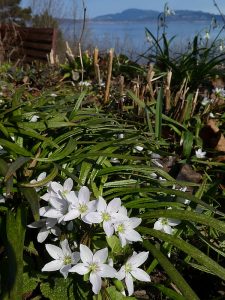
The one I grow is Claytonia virginica and last summer I found this monster tuber:

(see http://www.edimentals.com/blog/?p=18443)
I still haven’t got round to eating the tubers (Euell Gibbons was a fan!), but I regularly eat the spring leaves and flowers in mixed salads. I would love also to try other tuberous species like Claytonia caroliniana and C. tuberosa but have never seen a source :-(
More about spring beauties in Green Deane’s article here: http://www.eattheweeds.com/spring-beauty
9th April veggies
Lots of Hablitzia (stjernemelde), ground elder (skvallerkål), Svenskelauk (a form of Allium fistulosum), sweet cicely (spansk kjørvel), dandelion (løvetann), day lily shoots (daglilje), blanched horseradish shoots (pepperrot) and a variety of Allium victorialis (victory onion, seiersløk) which is the earliest form I grow along with one from the Kola peninsular in northern Russia; other varieties have hardly grown yet!
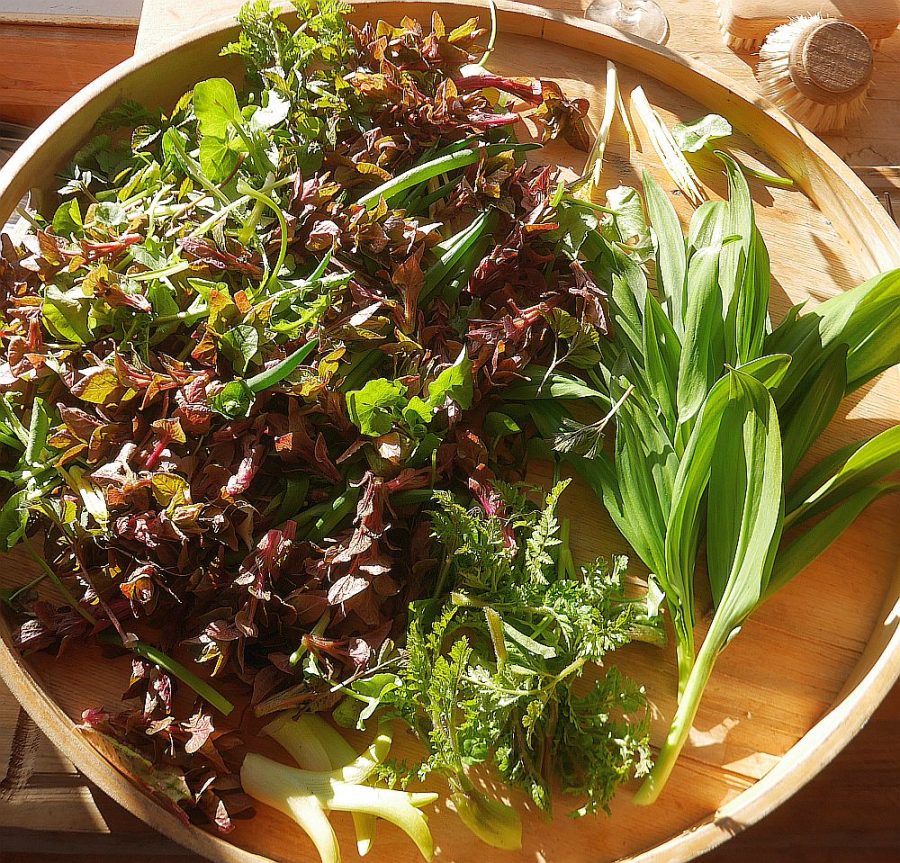
Hablitzia tour
A tour of my garden on 2nd April 2019 talking about one of my favourite perennial vegetables, Hablitzia tamnoides (Caucasian spinach). It’s extremely early yielding, productive, tasty, can be grown in complete shade, is very hardy and is nutritionally great too. I have currently about 11 different plants, 6 from old gardens in Scandinavia where people have been using Hablitzia as a spinach and salad crop for over 130 years and three wild accessions from the Caucasus. My oldest plant that you will see in this video was planted in 2002 and I’ve been harvesting since January this year, the reason the shoots are not very long! Nutritionally, Hablitzia is also definitely worth eating and contains particularly plenty of carotenoids, folates, calcium, magnesium, phosphorus and zinc. Also many other nutritional components were larger in Hablitzia than in spinach and New Zealand spinach (from a Finnish study). See http://www.edimentals.com/blog/?p=8606
More blanched dandelions
More dandelions brought up from the (dark) cellar, ready to eat! These roots were just stored in damp autumn leaves!


